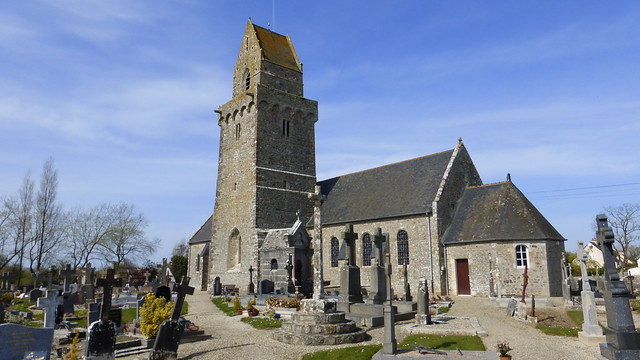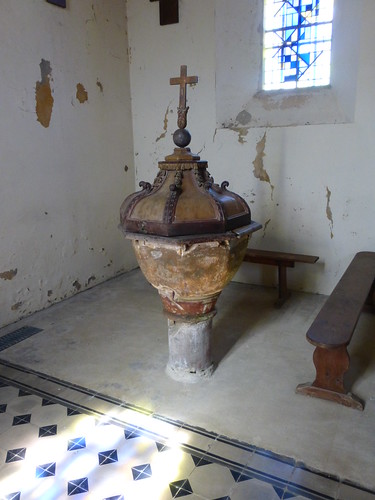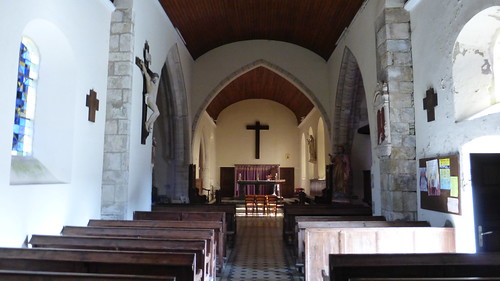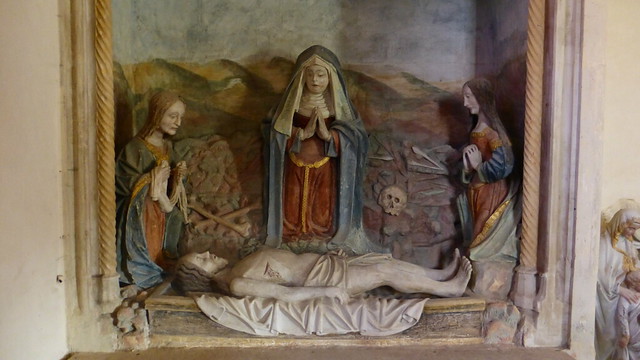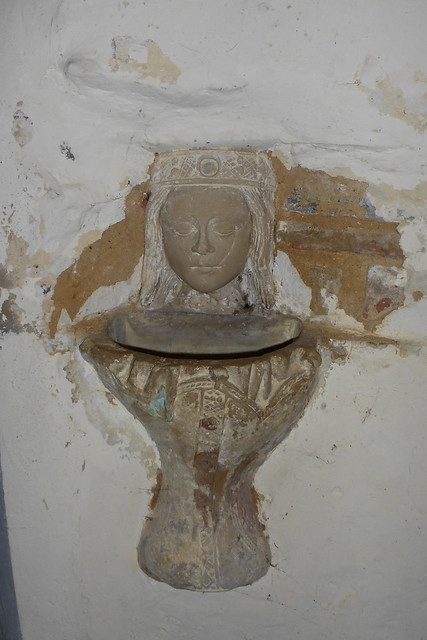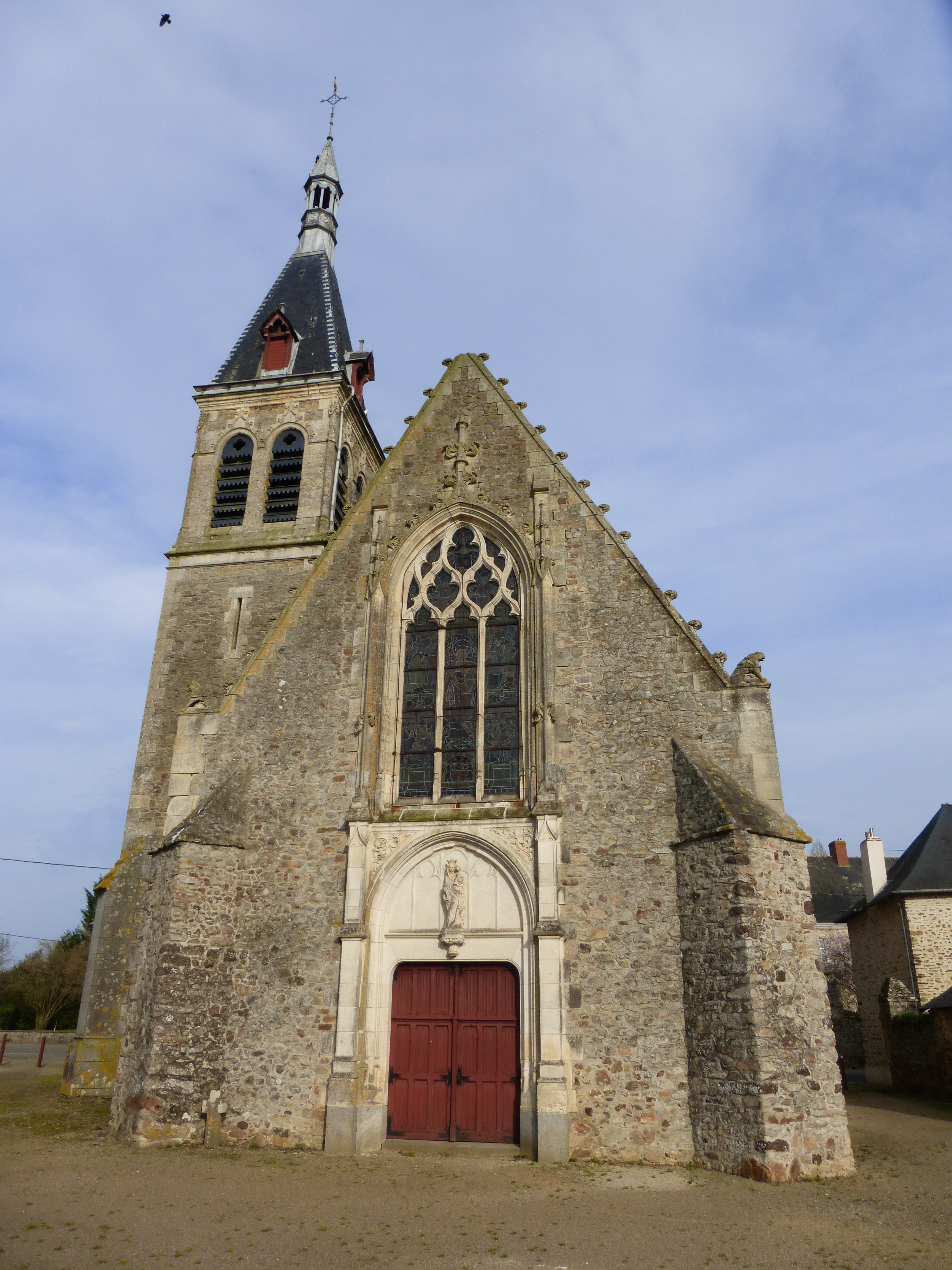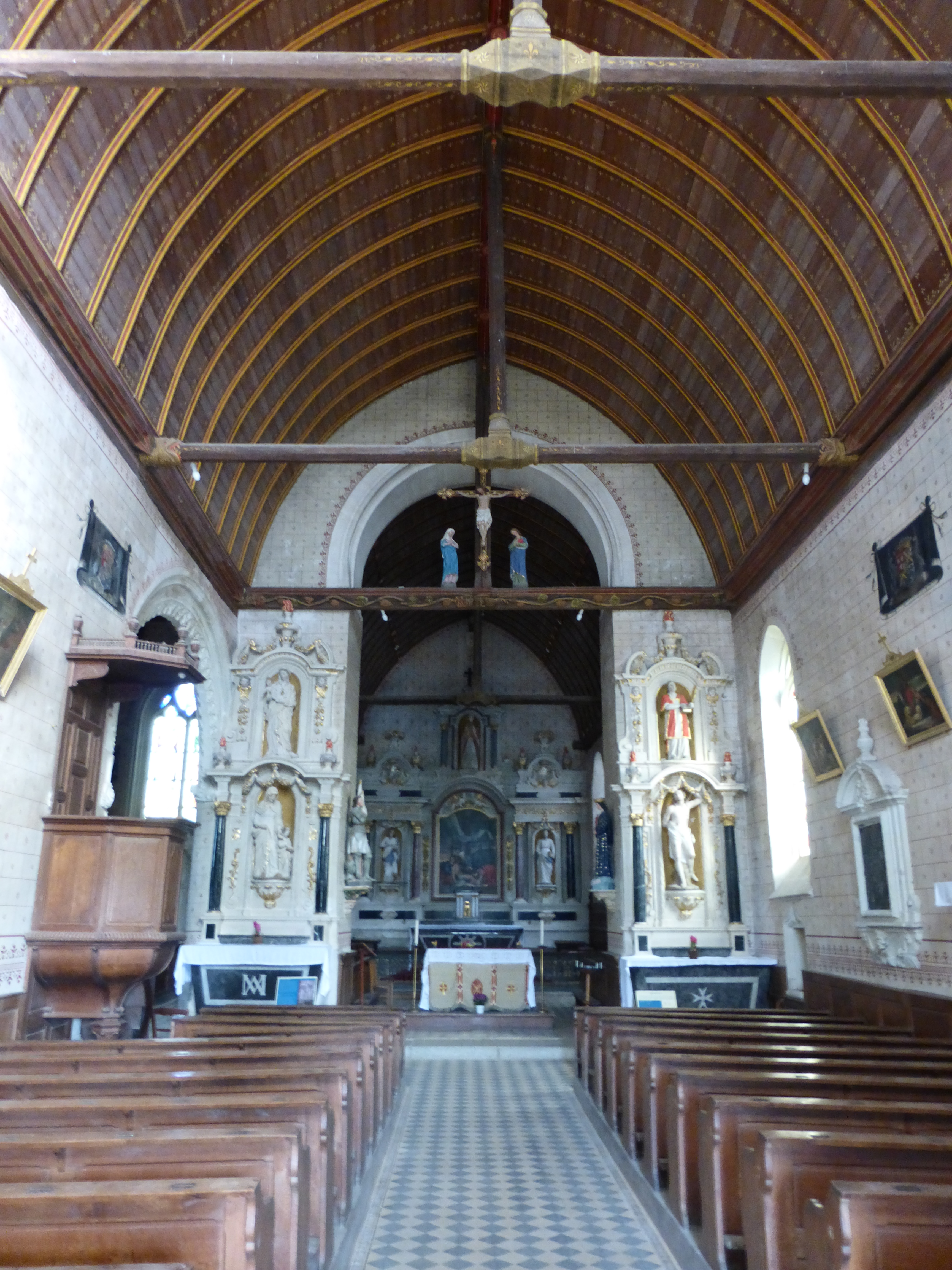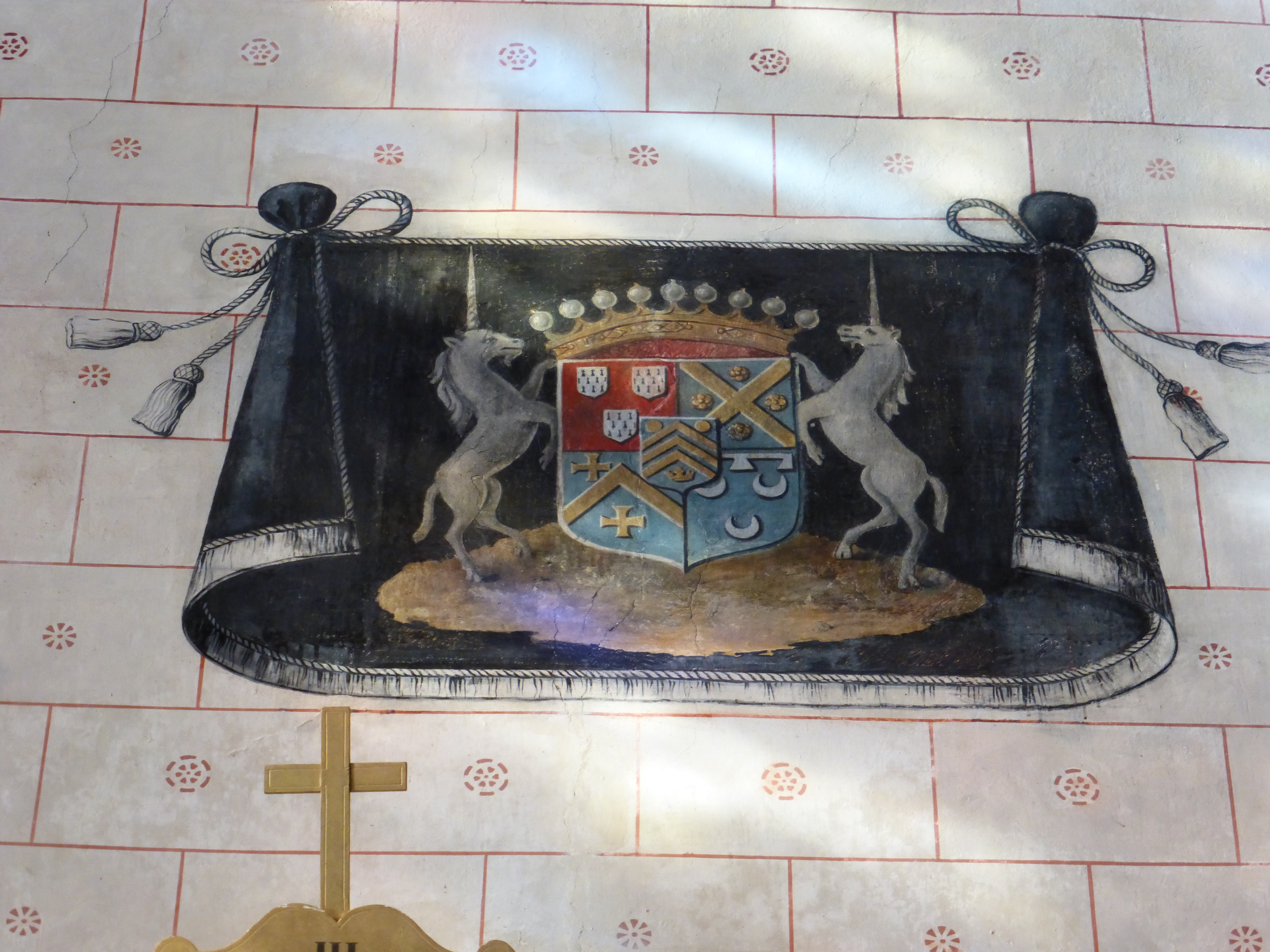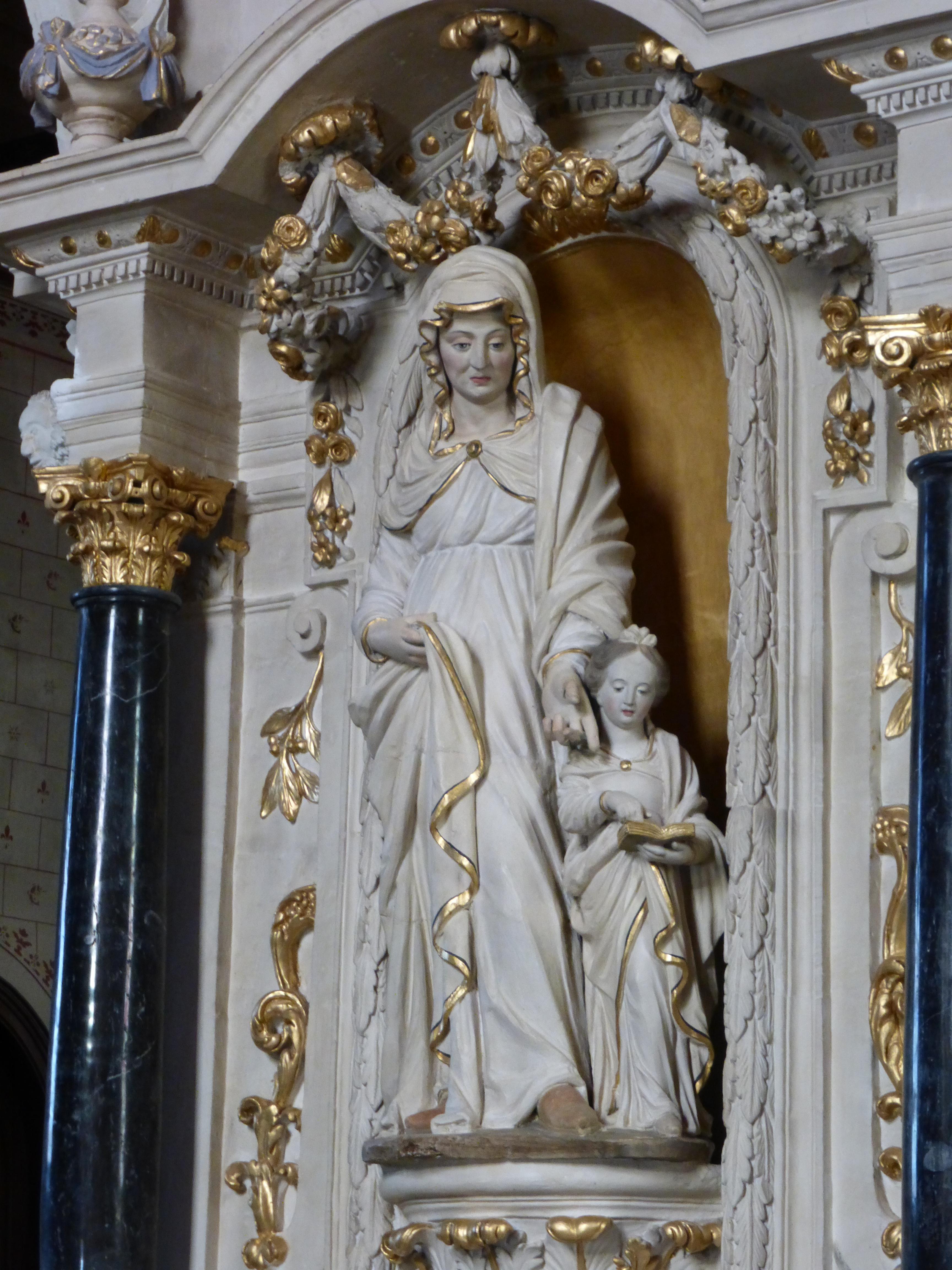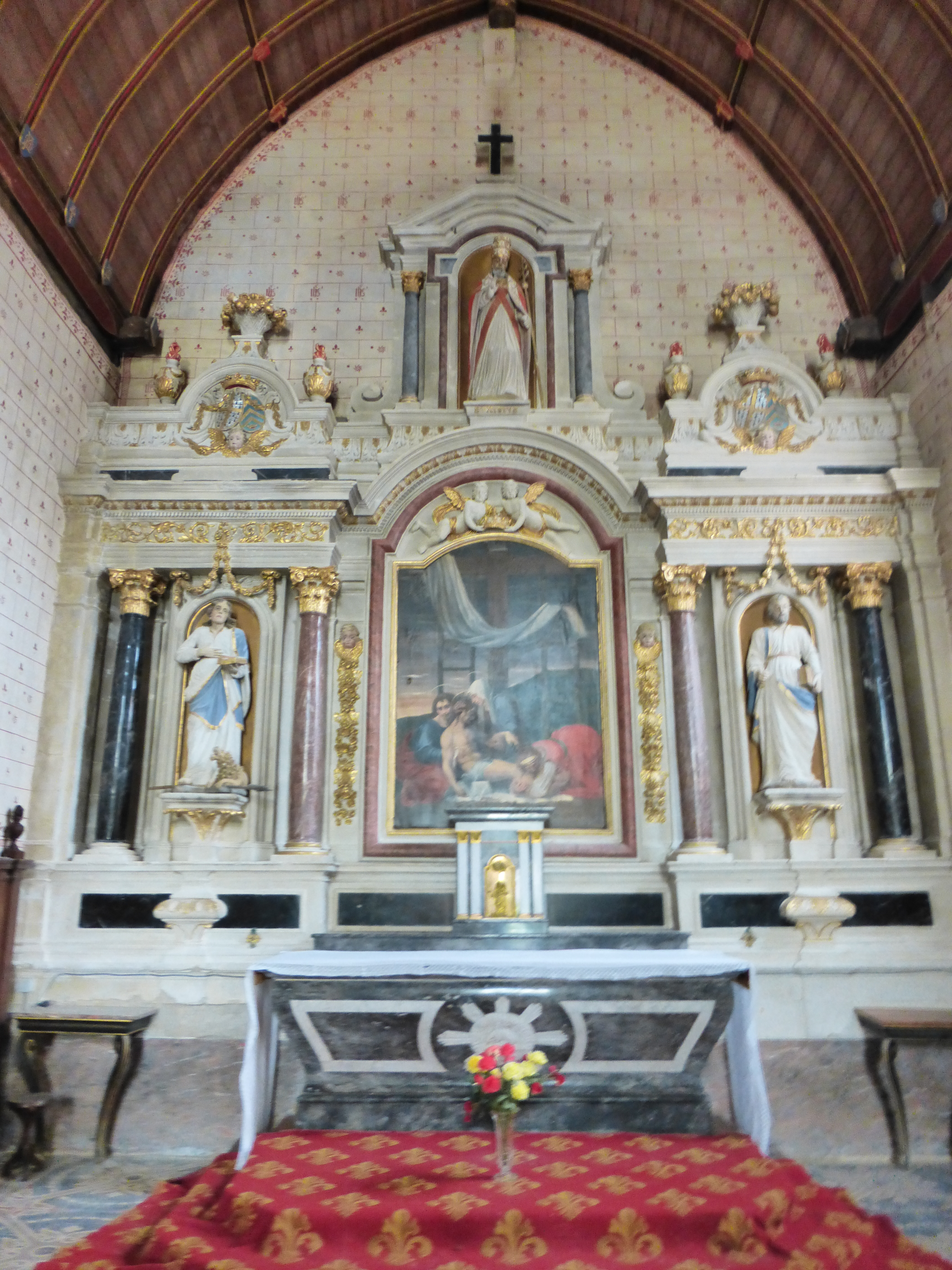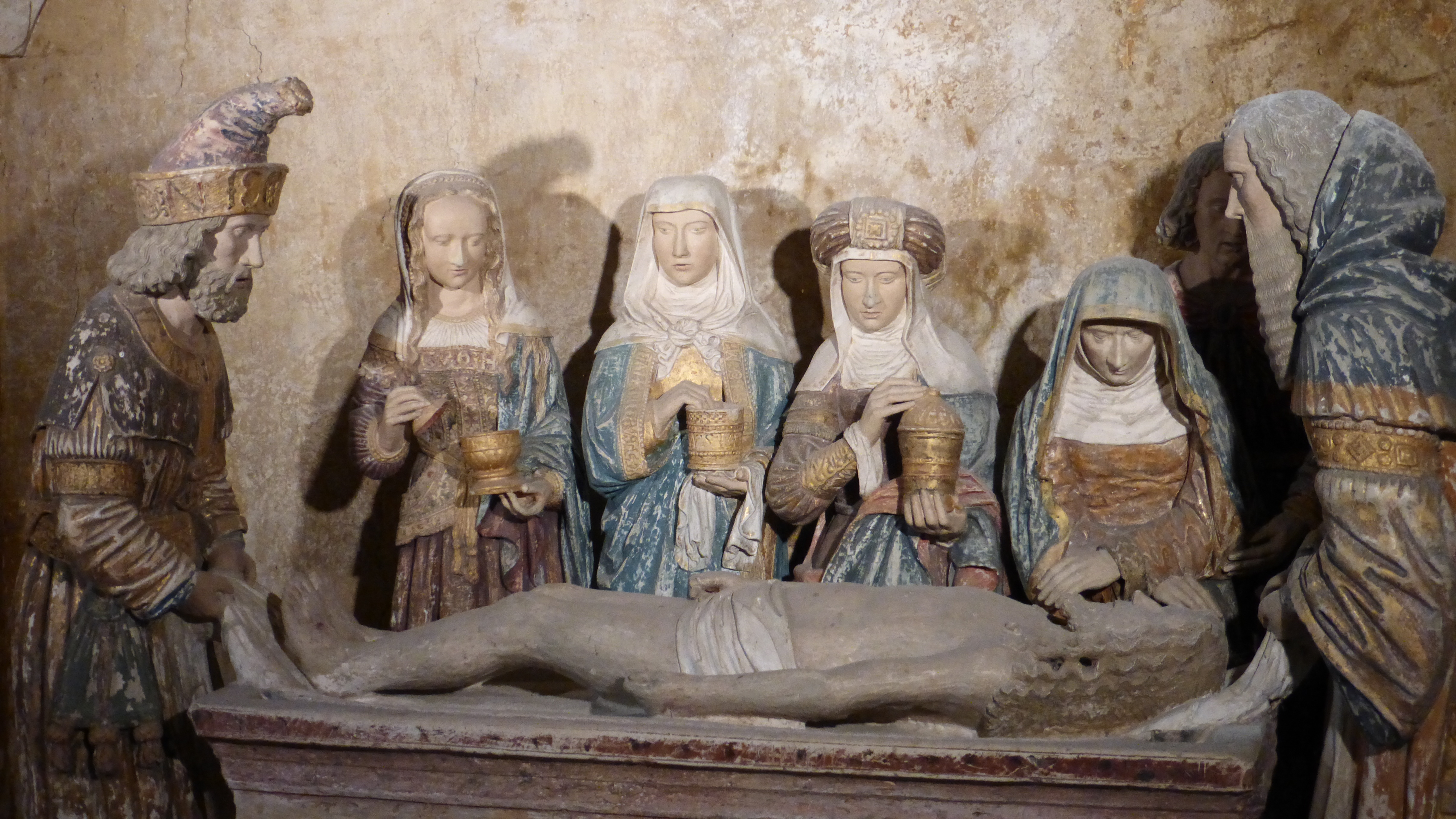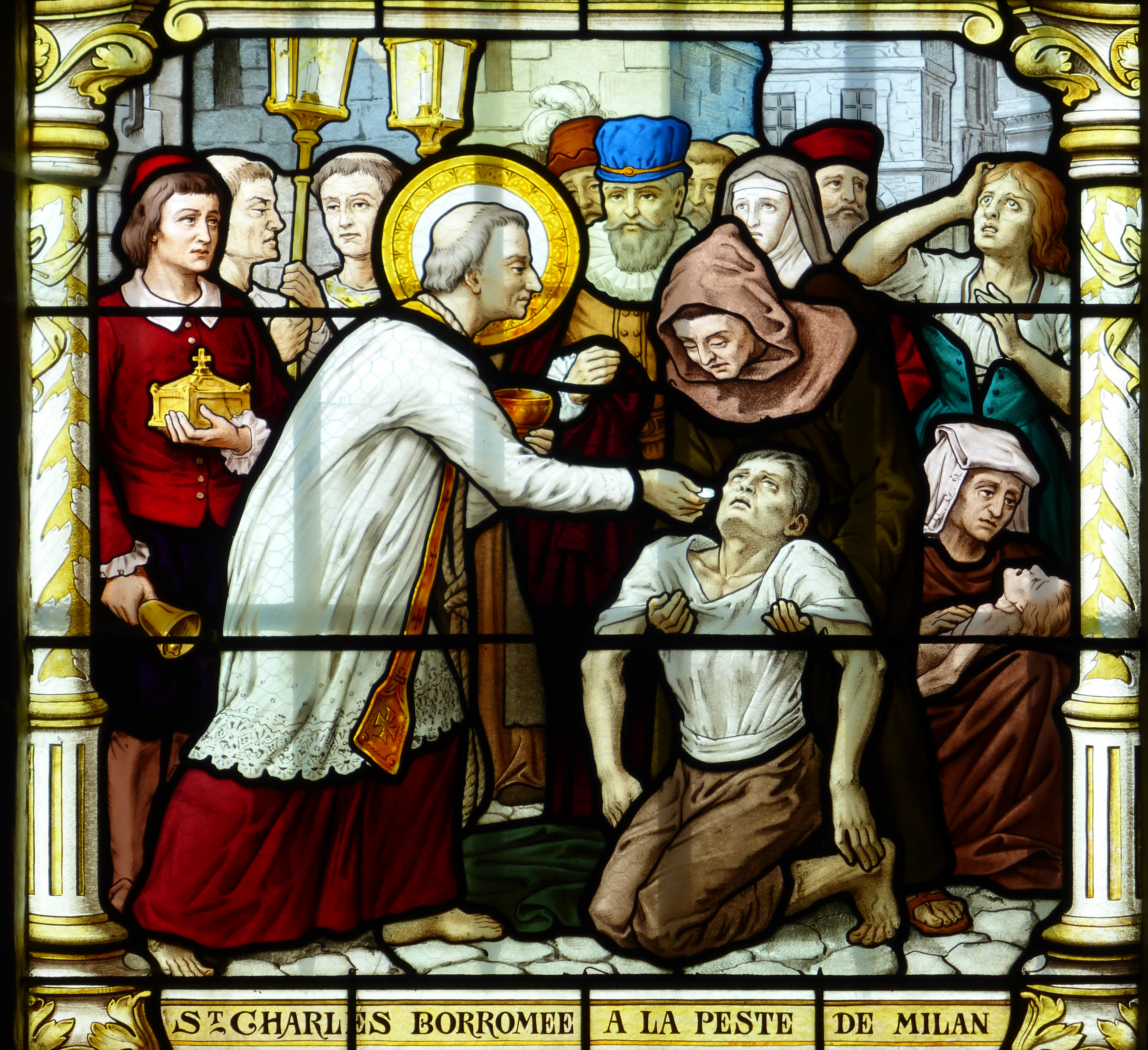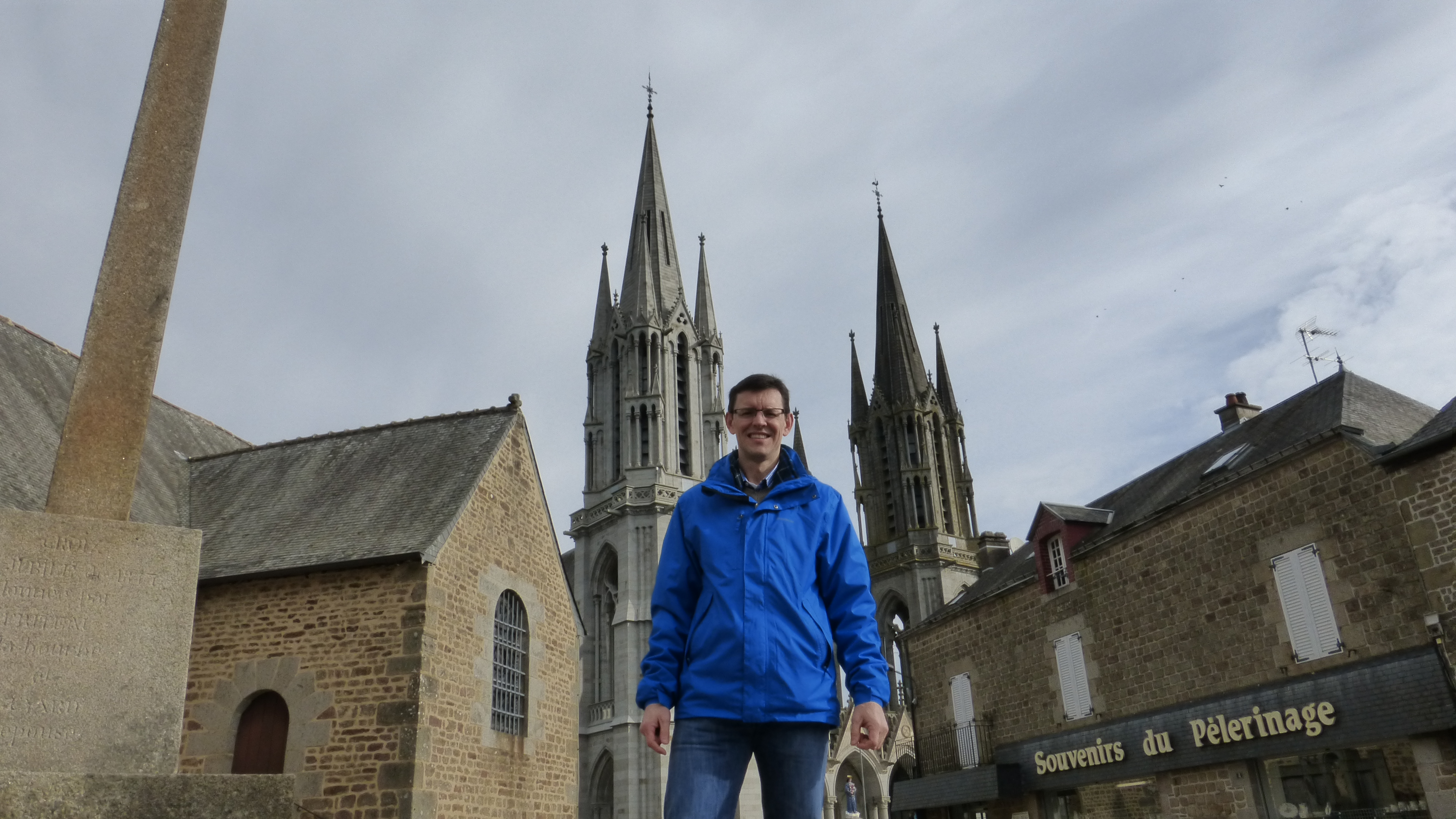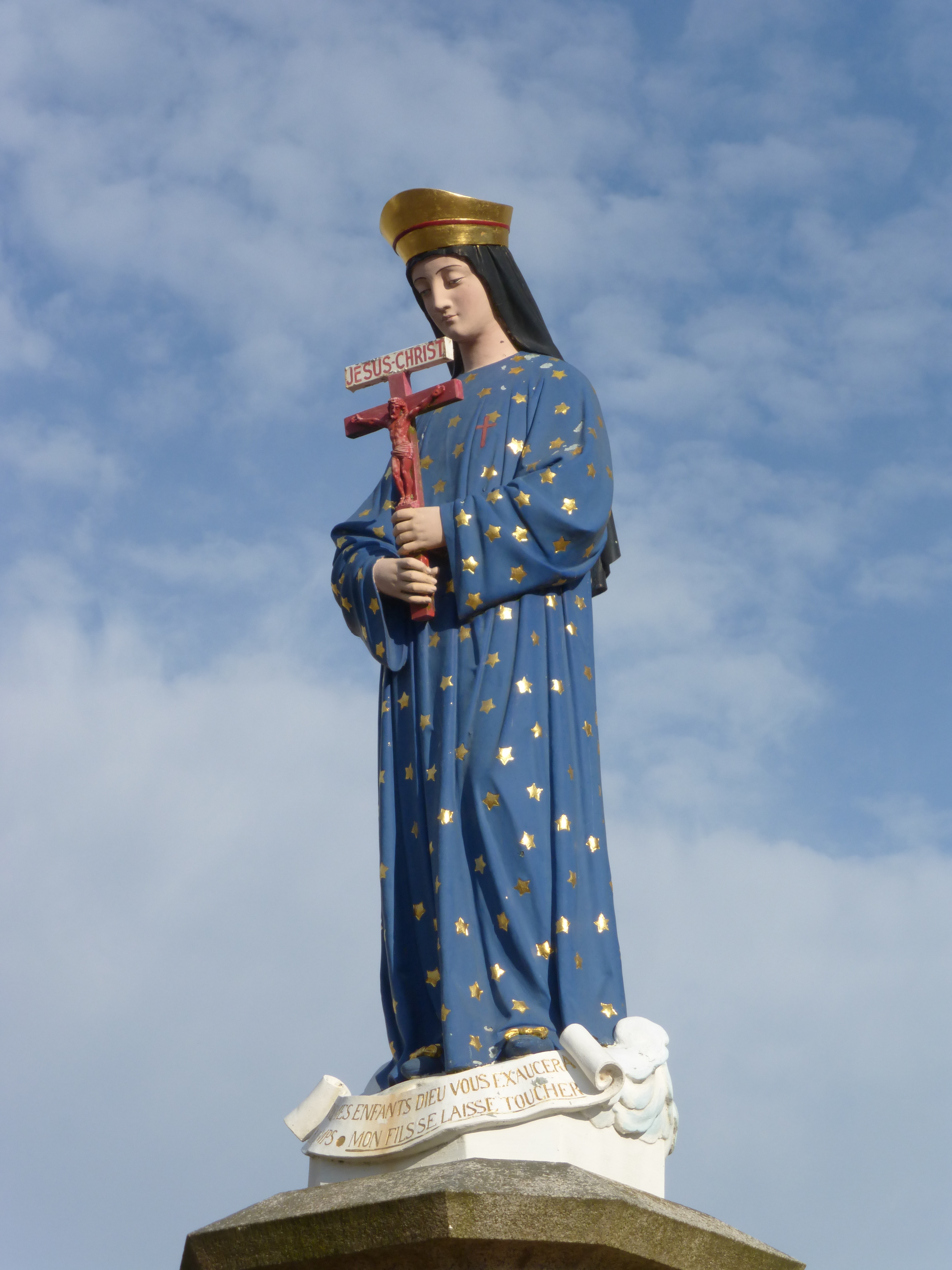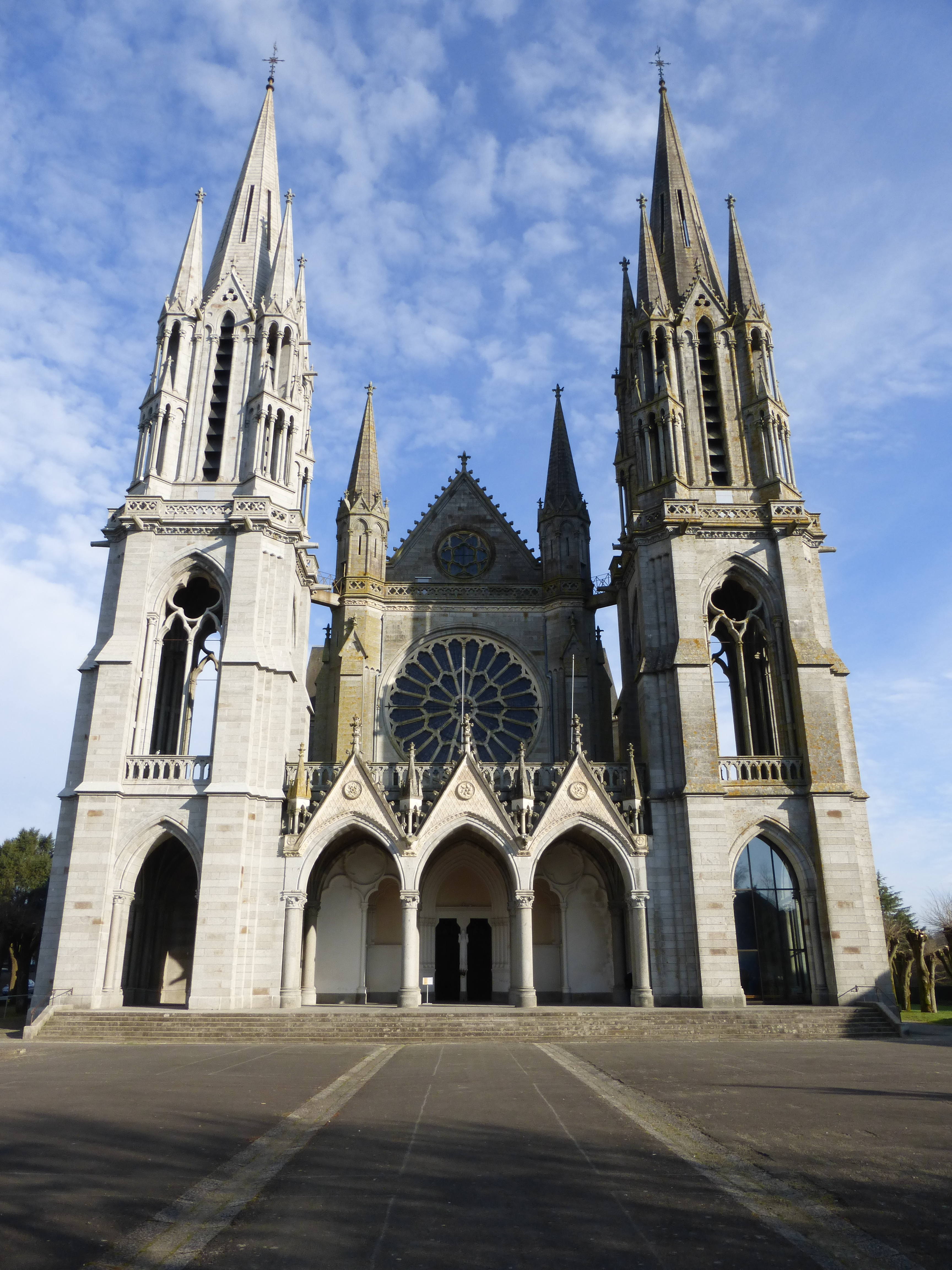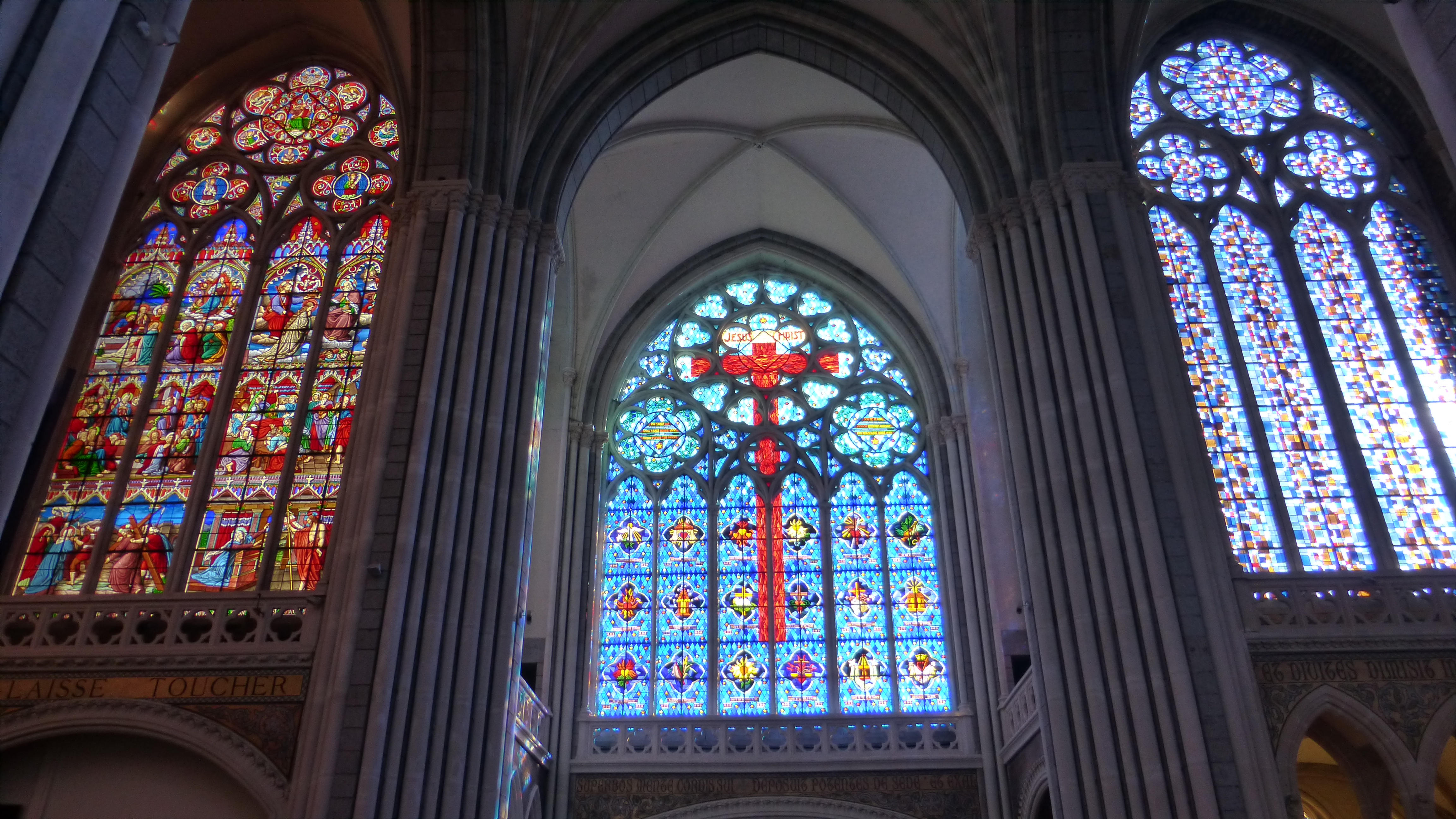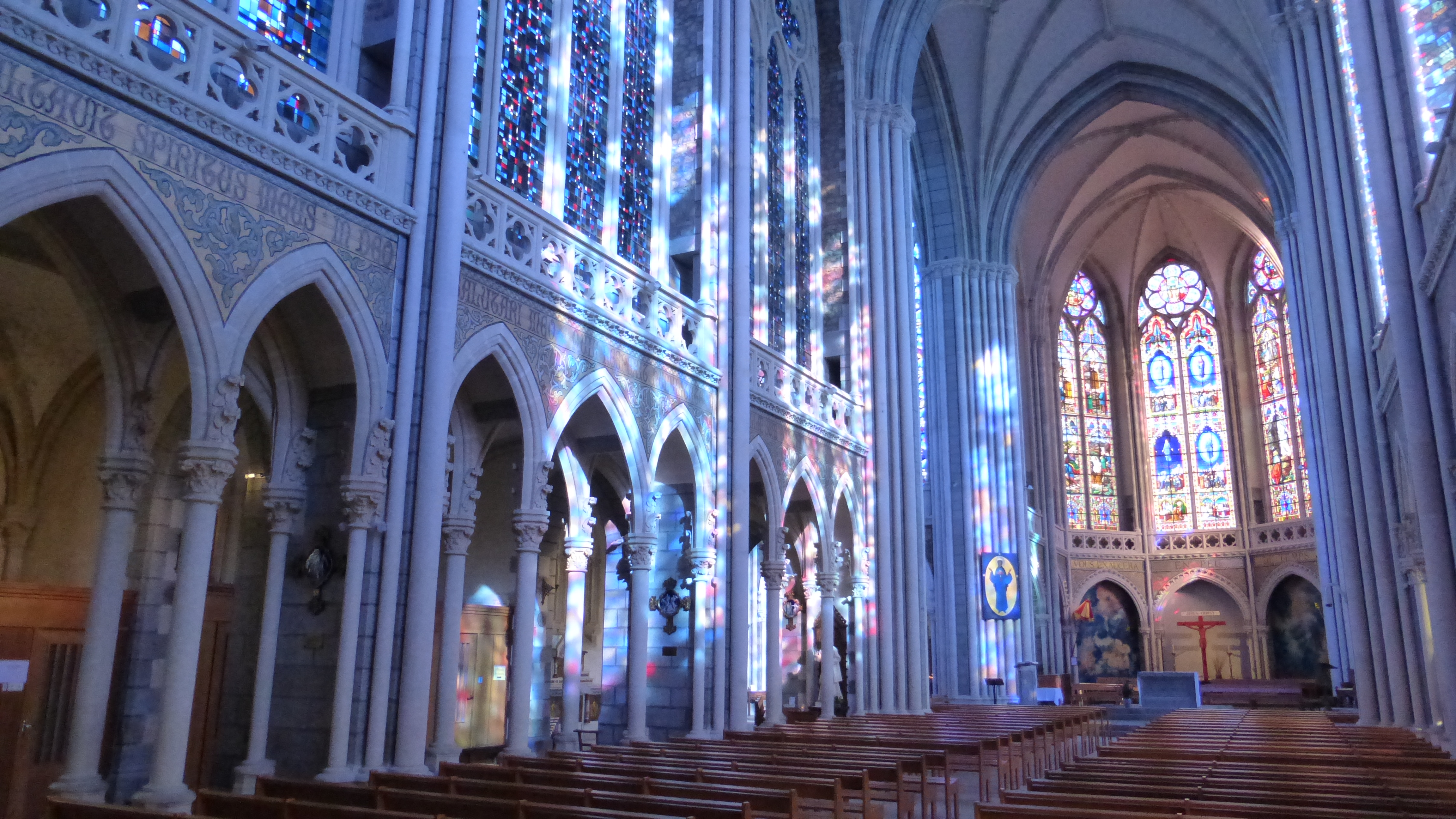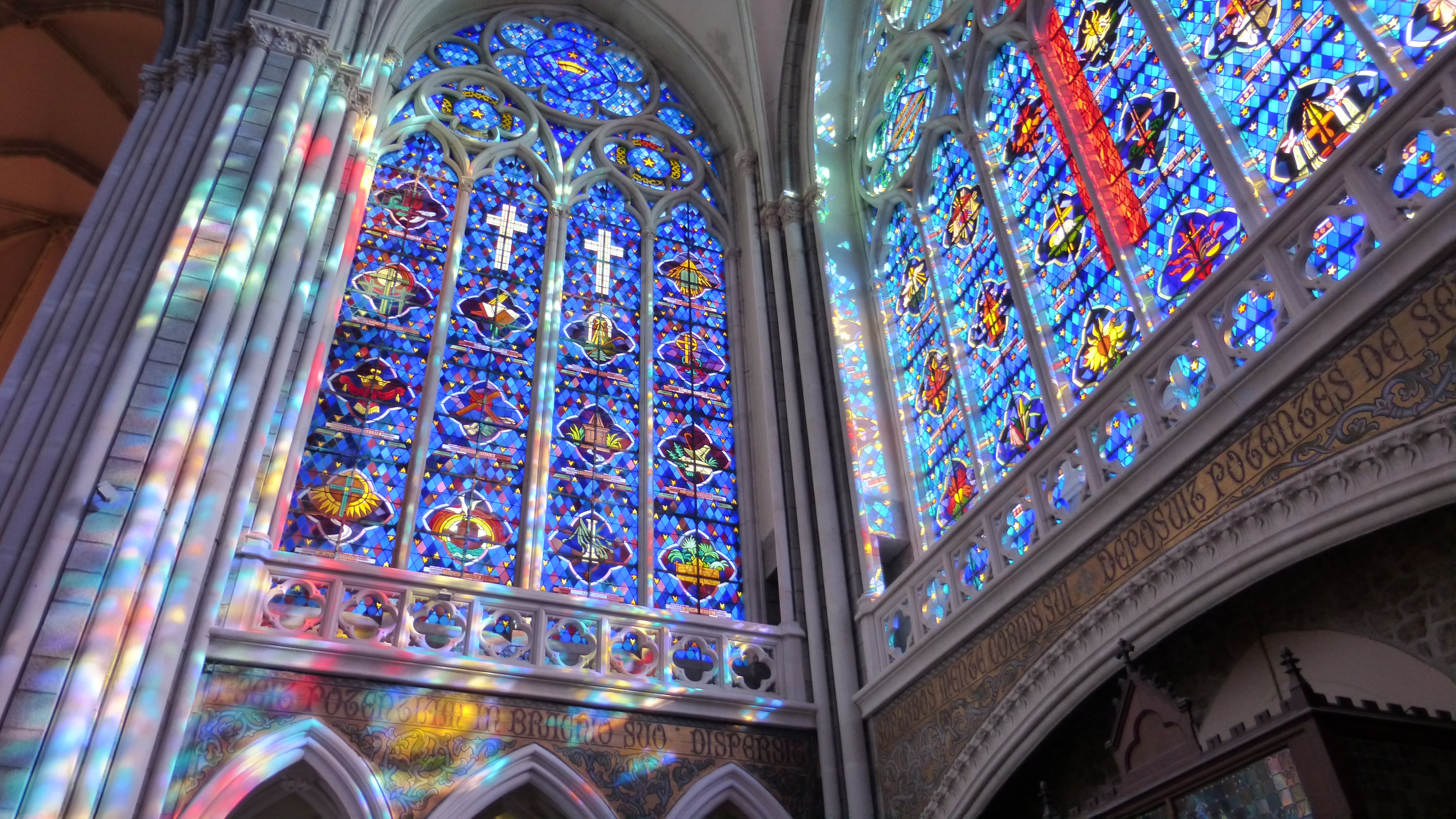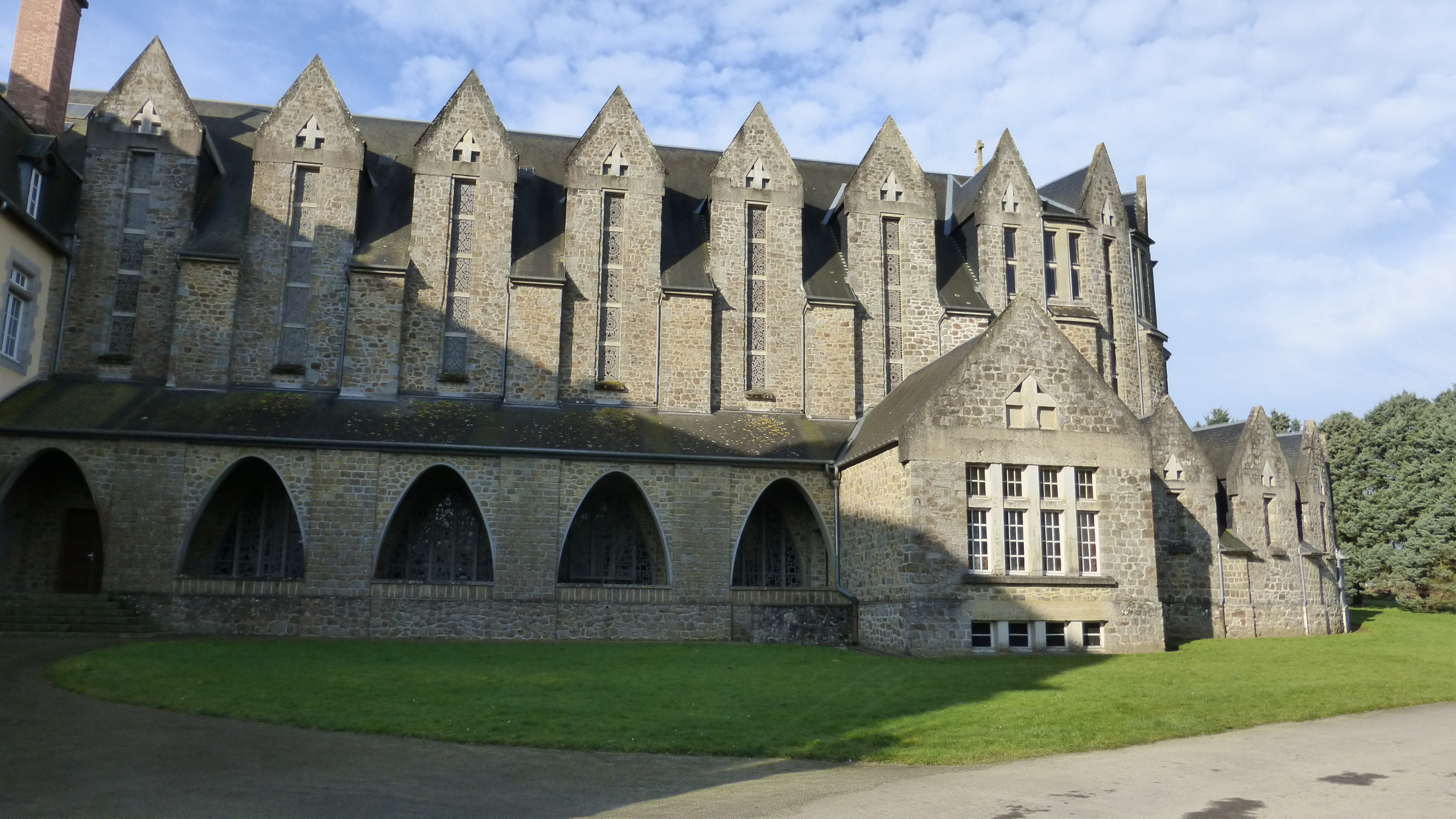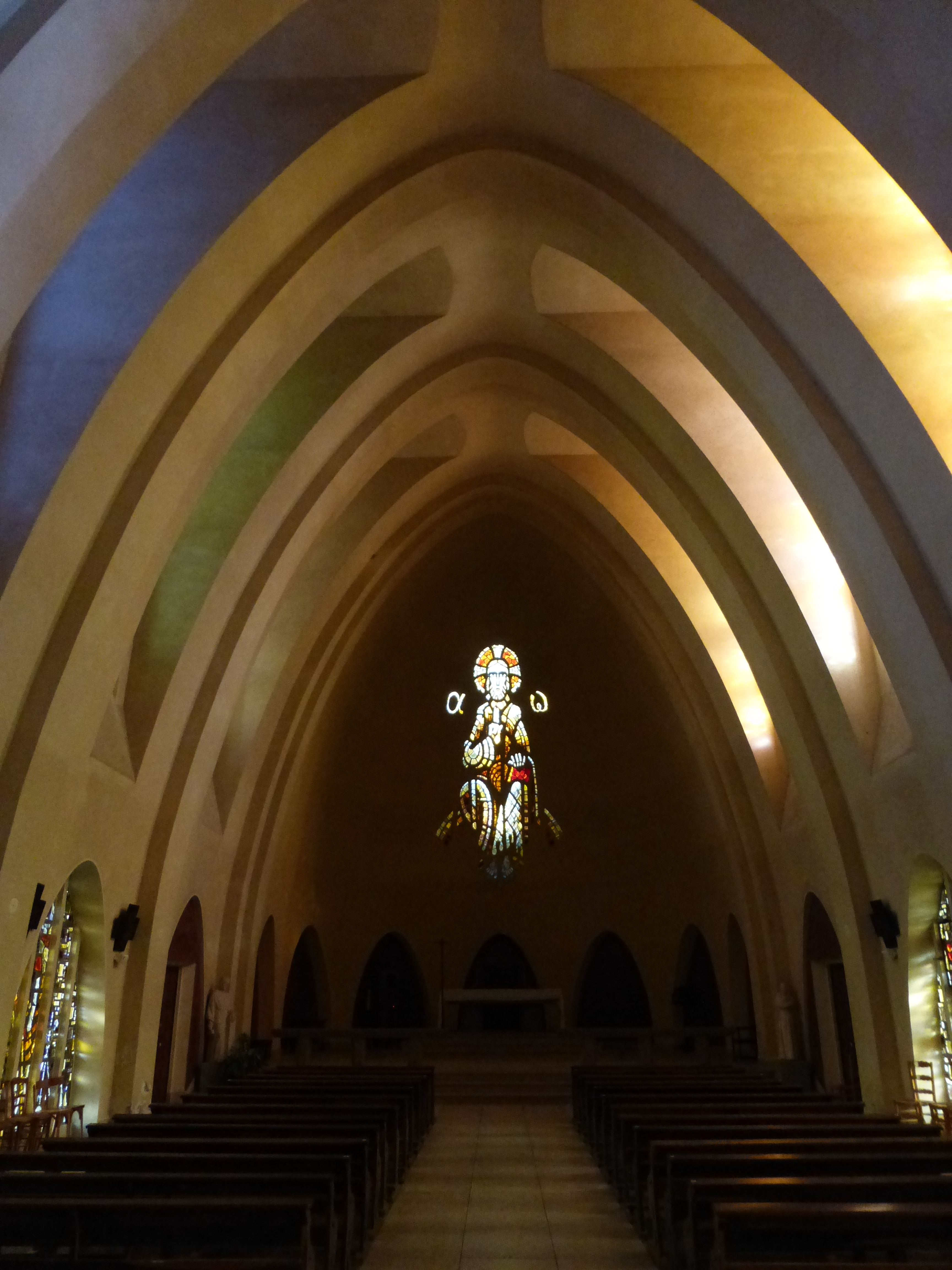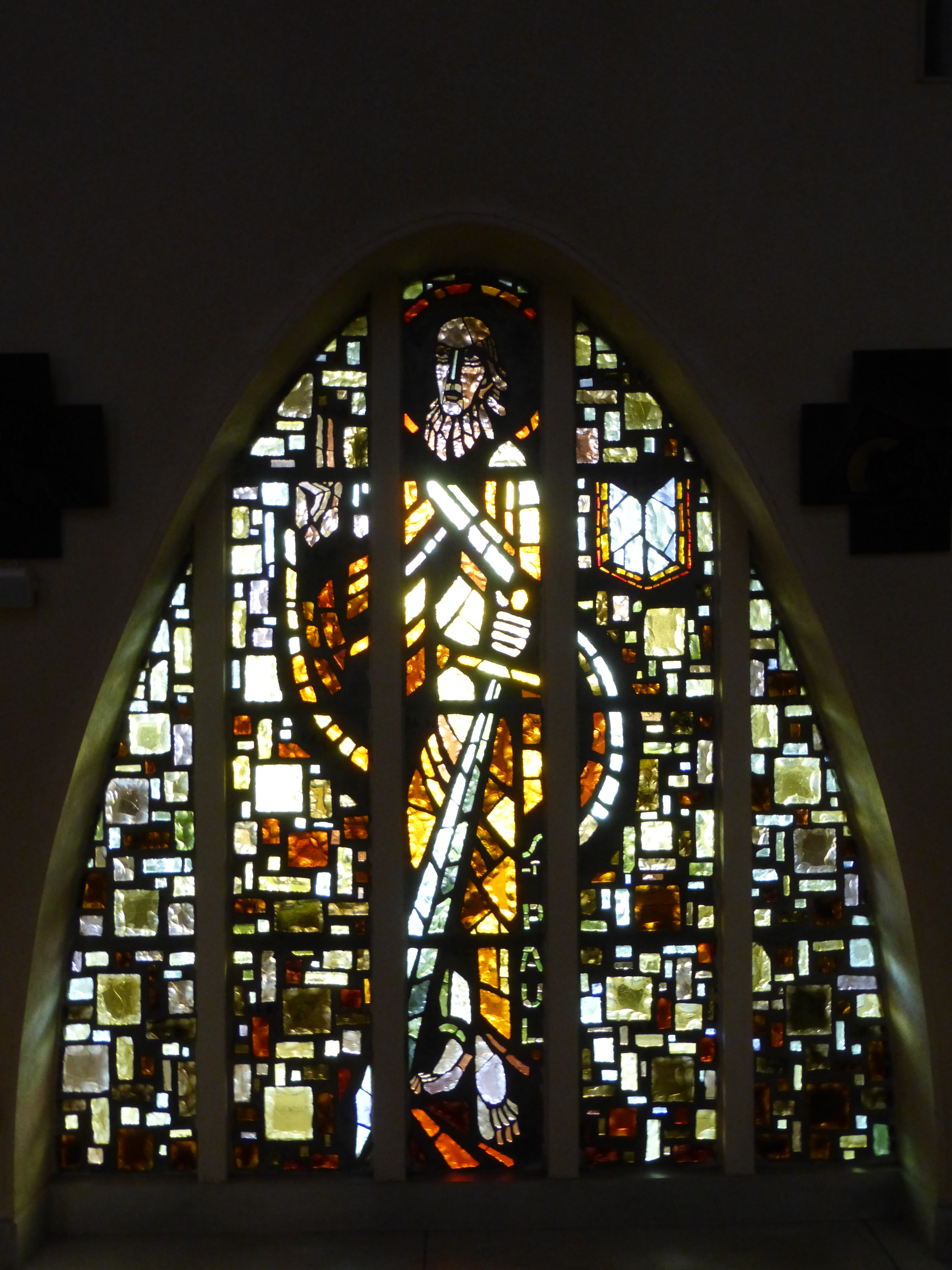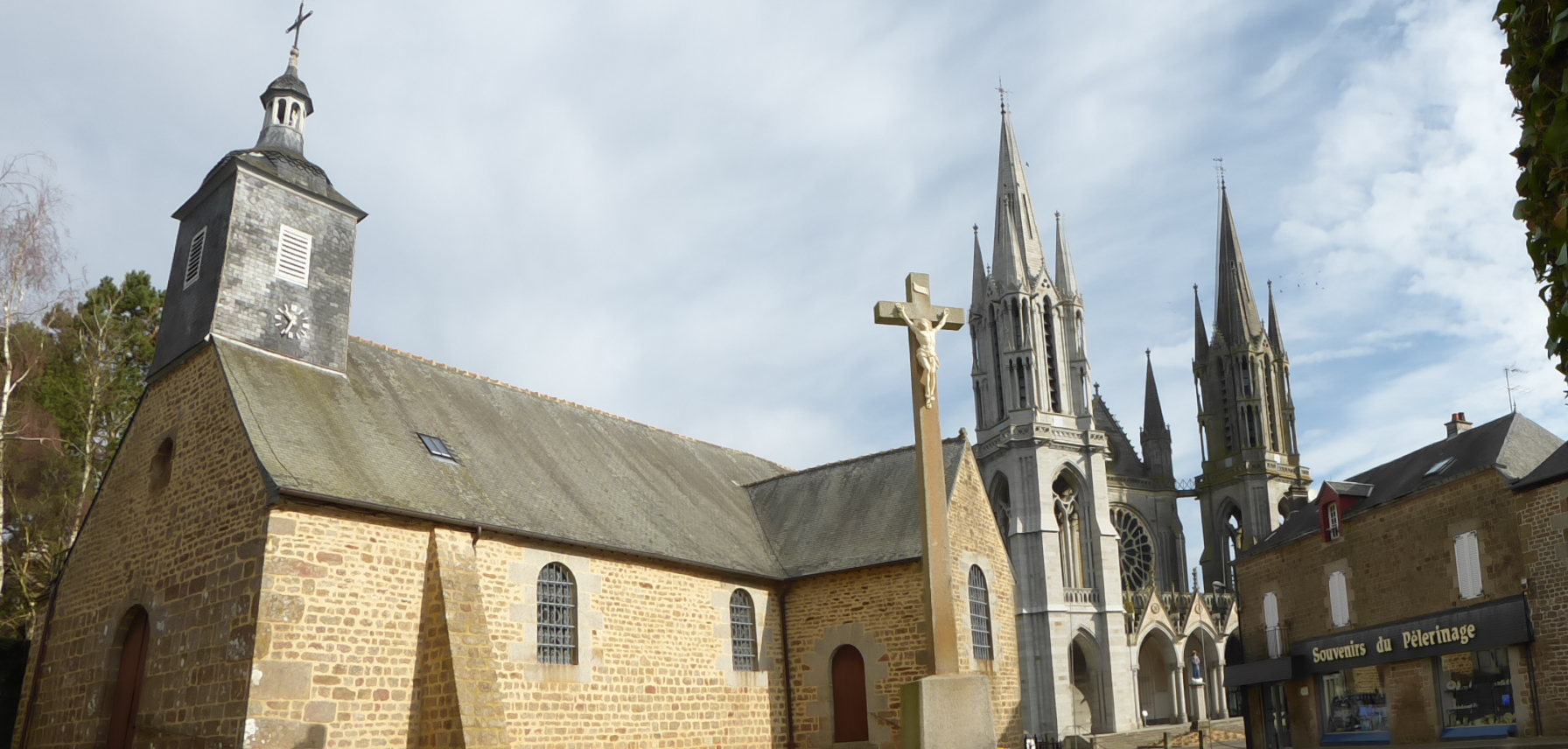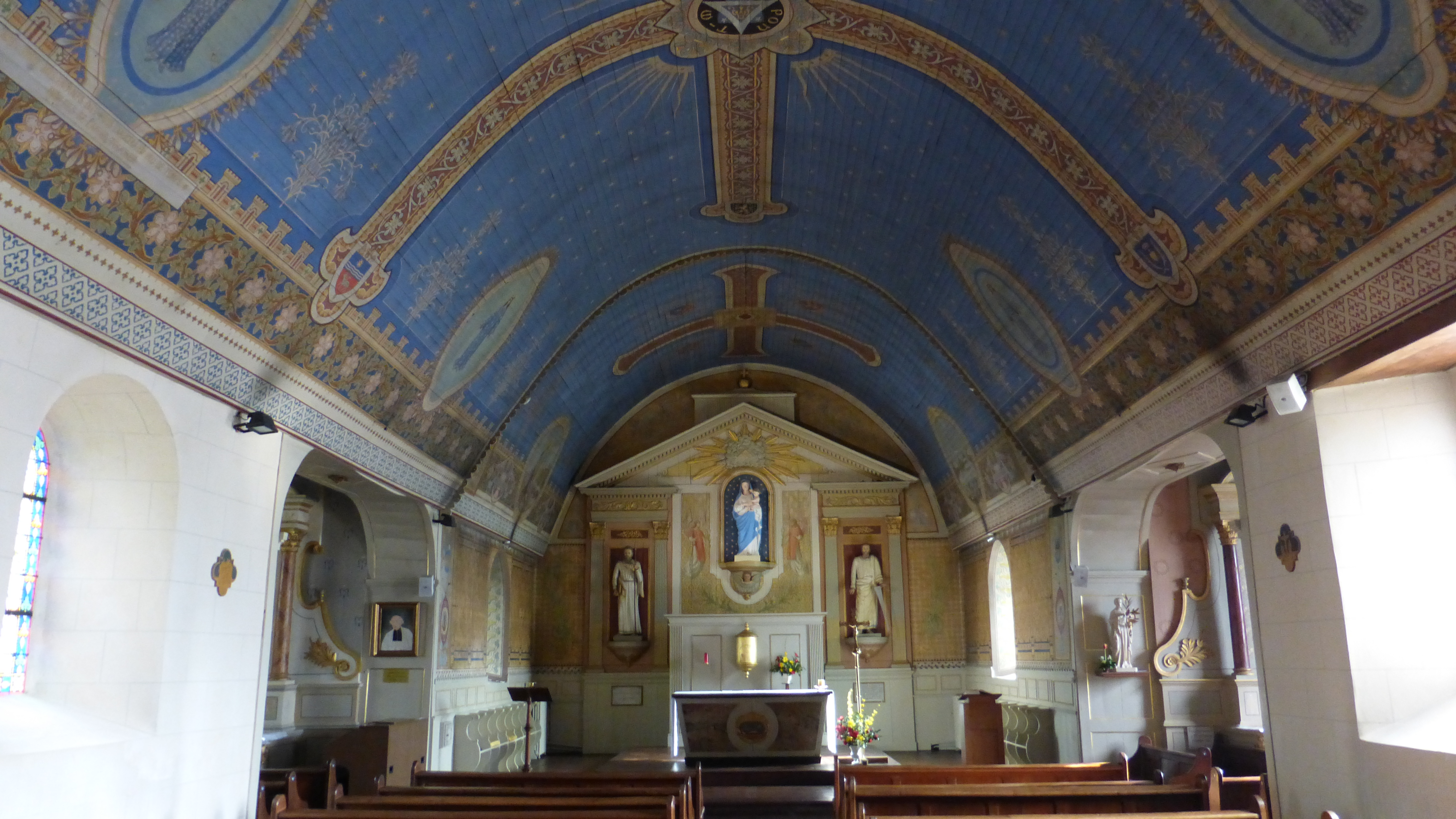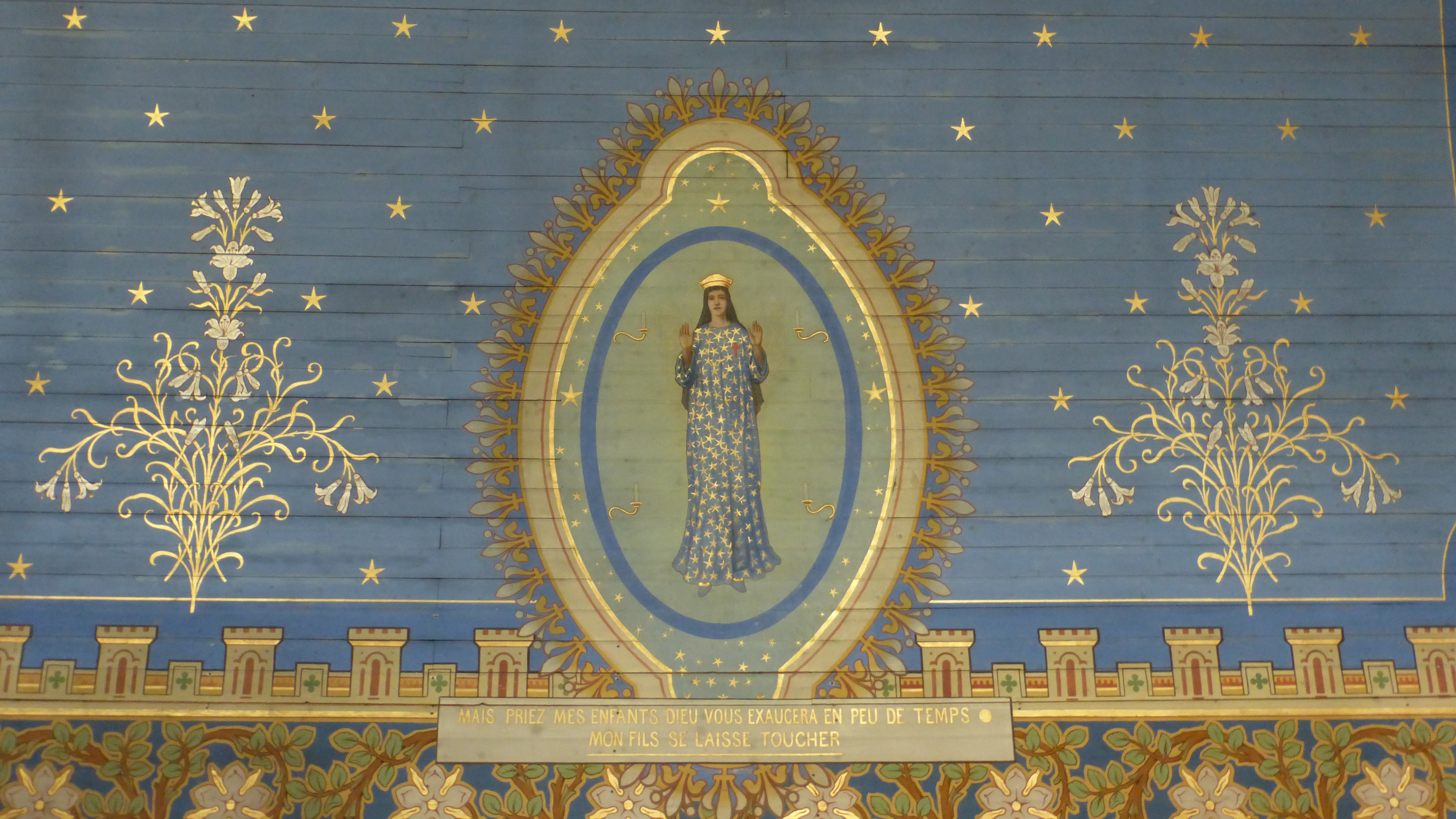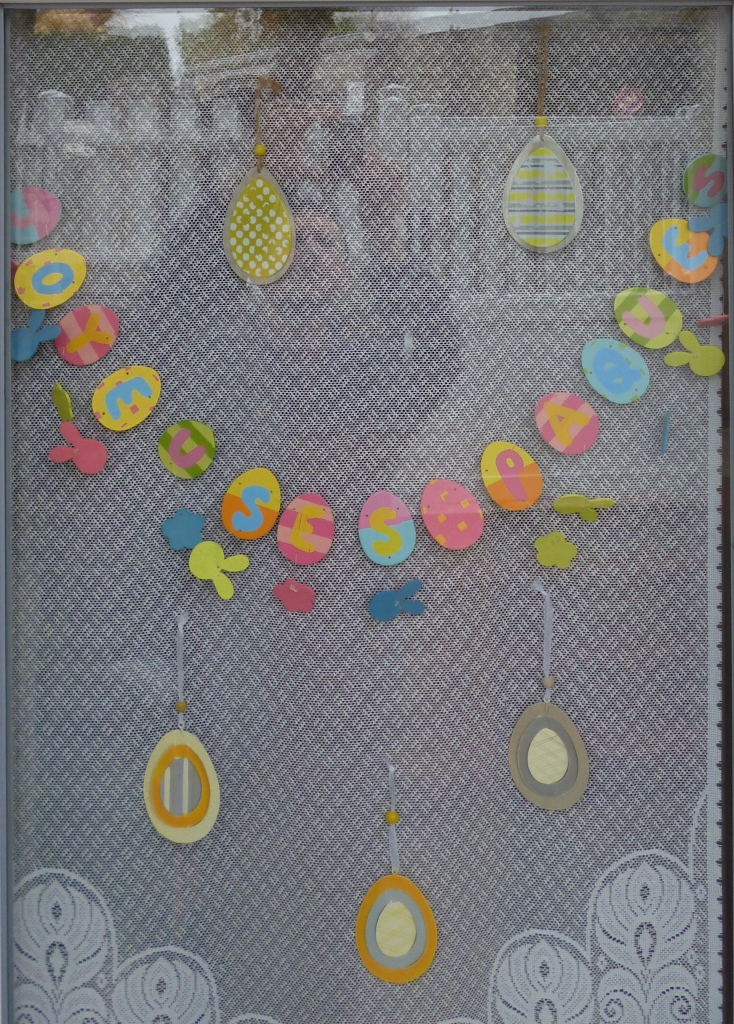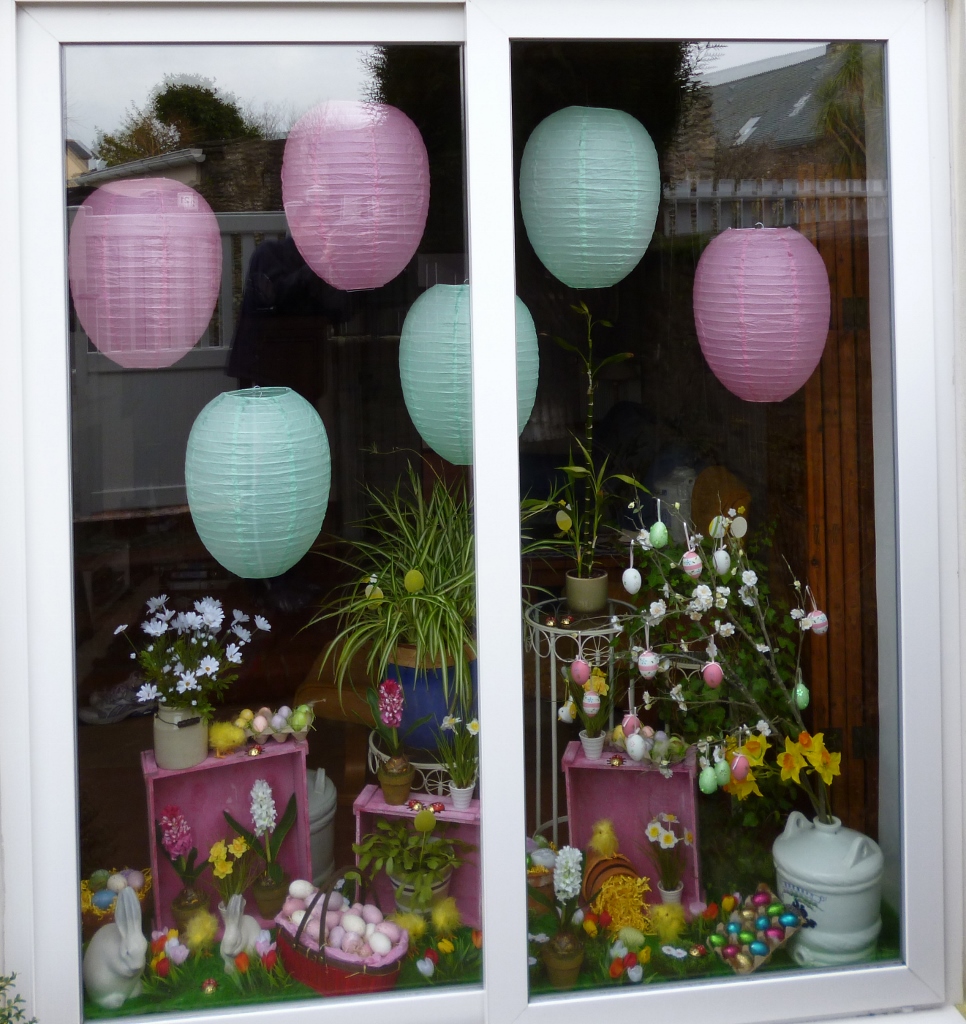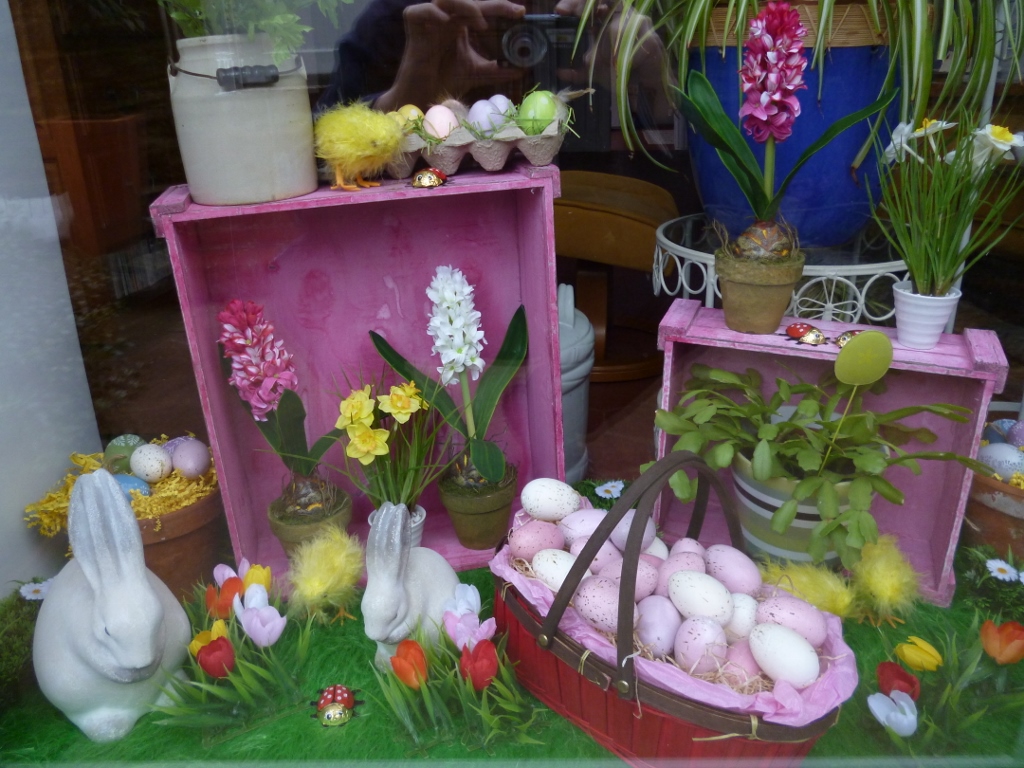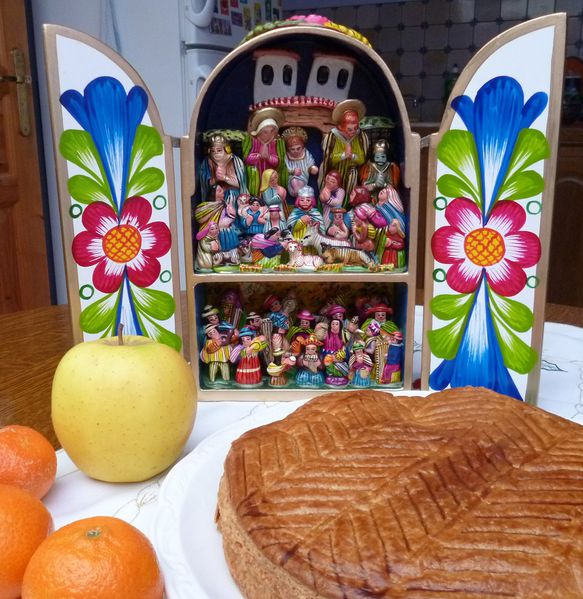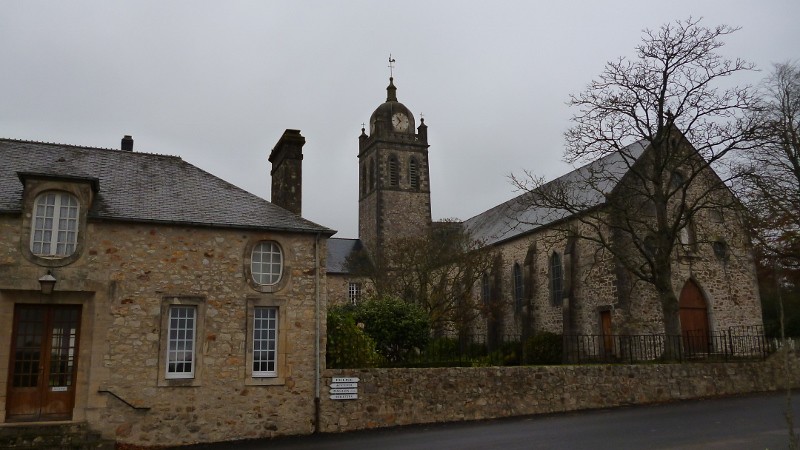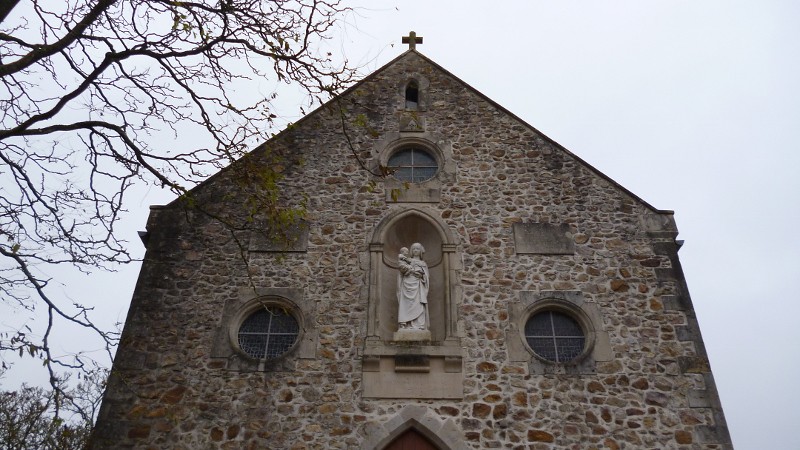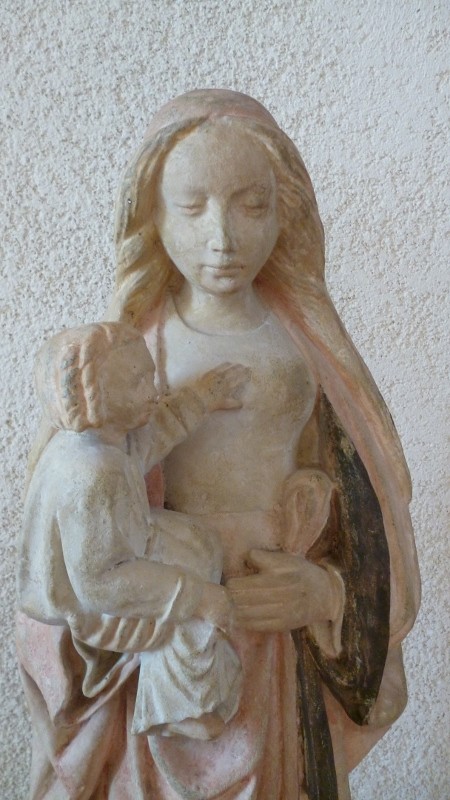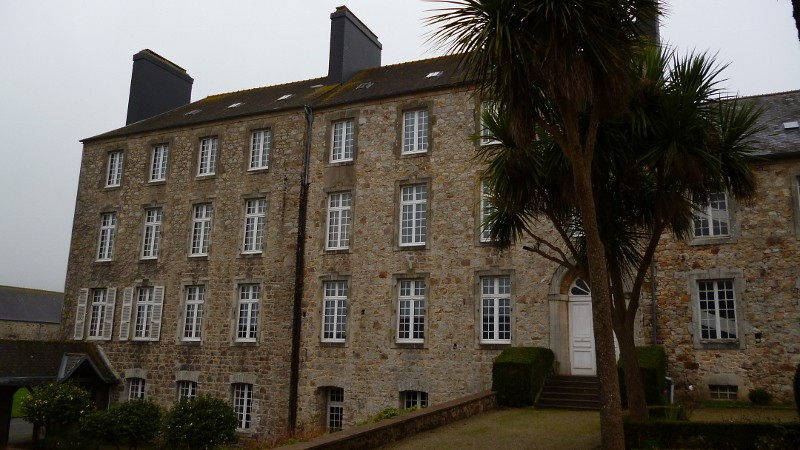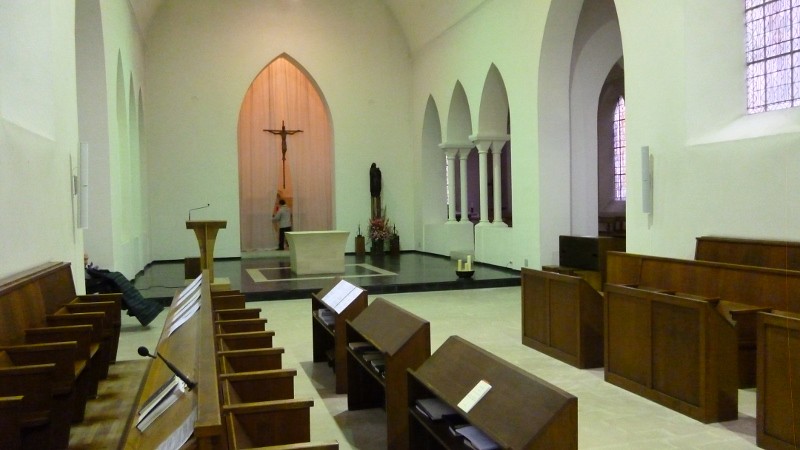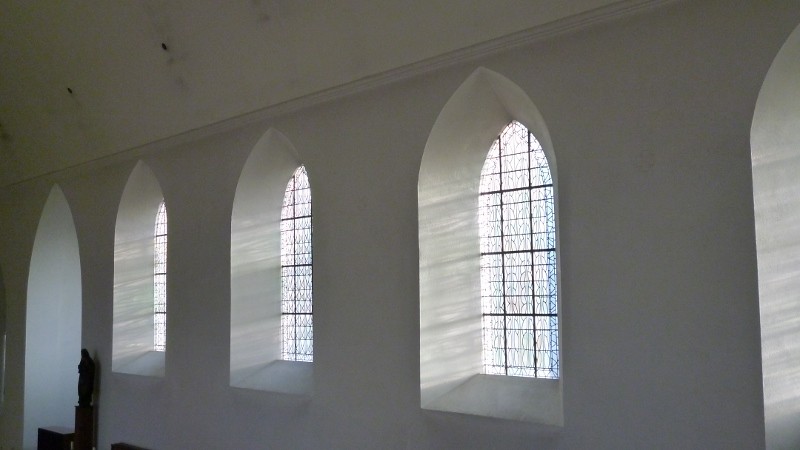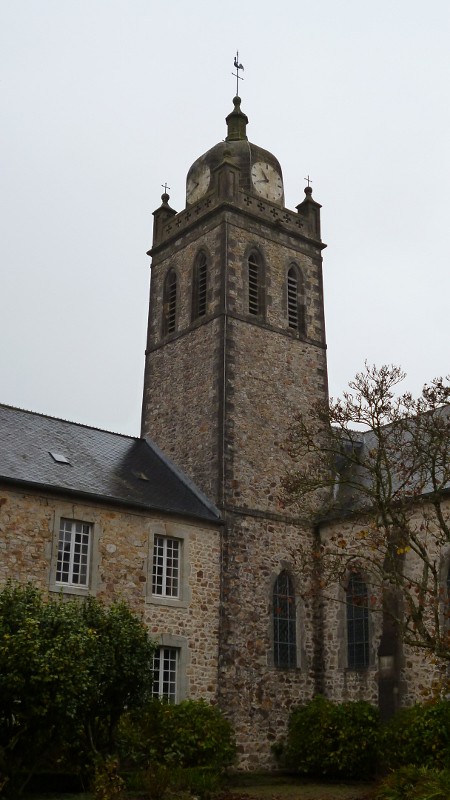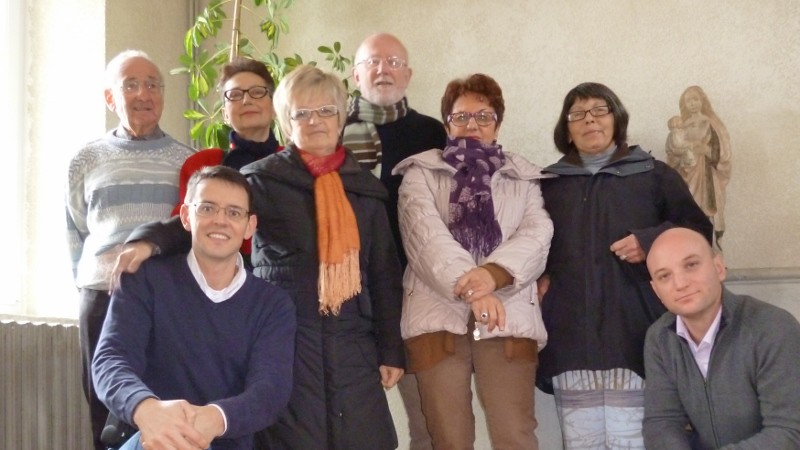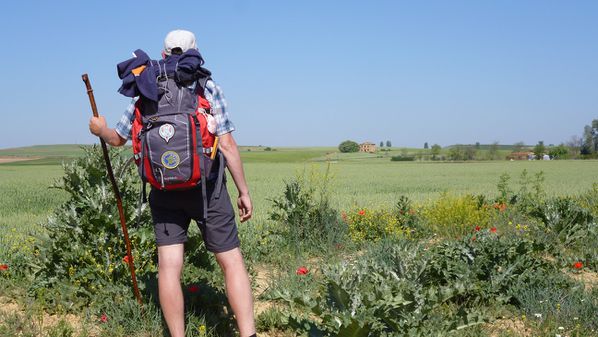July 20 2014
7
20
/07
/July
/2014
14:57

Well, this was one of those pleasant surprises that you just don’t come across that often. After visiting the church in Vesly, I wanted to find the Chapelle Notre-Dame de la Consolation but was disappointed when I couldn’t find any signs in town leading me there. I ended up driving in the wrong direction and found myself in Gerville-la-Forêt where I came across another church called Église Saint-Pair (which happened to be closed). Fortunately, there was a large map posted just in front of the church that gave directions to the chapel. So, I drove back into Vesly and found it without any further problems. It is nestled at the highest part of the town at the top of a path leading to the parsonage, past the local soccer field in amongst a small copse of trees. The chapel has been restored several times over the centuries. Information in a variety of languages can be found inside but there is very little information about the history of this chapel online. I’ll reprint what I found here: 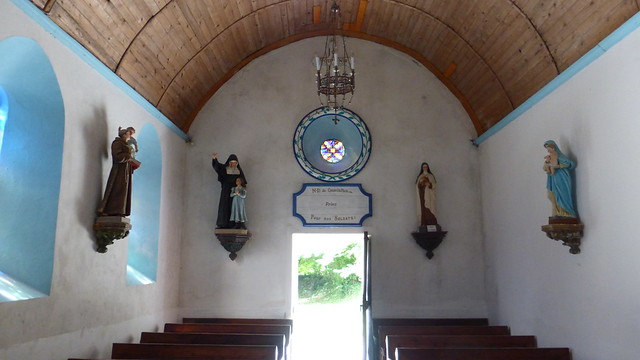 In the 13th century, a gentleman was riding in the vicinity of the place where the chapel is now standing. Suddenly, he came across a boar which rushed at the horse. The horse bolted and knocked the knight down. Unfortunately, one of the knight’s feet got stuck in the stirrup and he was dragged by the bolting horse. When he was about to die, the gentleman promised the Blessed Virgin that he would build a chapel at the very place where his life would be spared. His foot being released, the gentleman soon set about fulfilling his vow. He dedicated the chapel he built to Our Lady of the Stirrup (Notre-Dame de l'Étrier) or of the Saddle (Notre-Dame de la Selle). Such is the origin, according to legend, of the Vesly Chapel.
In the 13th century, a gentleman was riding in the vicinity of the place where the chapel is now standing. Suddenly, he came across a boar which rushed at the horse. The horse bolted and knocked the knight down. Unfortunately, one of the knight’s feet got stuck in the stirrup and he was dragged by the bolting horse. When he was about to die, the gentleman promised the Blessed Virgin that he would build a chapel at the very place where his life would be spared. His foot being released, the gentleman soon set about fulfilling his vow. He dedicated the chapel he built to Our Lady of the Stirrup (Notre-Dame de l'Étrier) or of the Saddle (Notre-Dame de la Selle). Such is the origin, according to legend, of the Vesly Chapel. 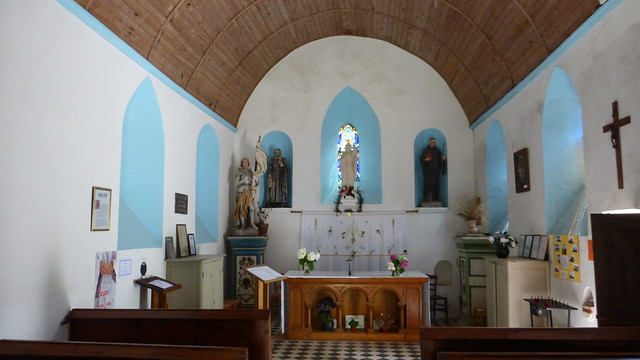 As for its cloister, in the 14th and 15th centuries, it was used as the burial place for the local gentry. Over the years, many old sarcophagi have been found here during archaeological digs. In 1650, Father John Eudes, preaching a mission in Vesly, found the chapel nearly in ruins. It was a long time since Mass had been said. The missionary announced a procession to the chapel on Easter Tuesday. The parishioners of Vesly and of the neighbourhood responded to the appeal. Father Eudes then felt a desire to restore the chapel of the Blessed Virgin during his stay in Vesly. This task was undertaken so eagerly that the missionary was able to say Mass in the newly restored chapel at the end of his mission. Seeing this achievement as a good sign from the Blessed Virgin that his mission was a success, Father Eudes then dedicated the chapel to Our Lady of Consolation which is now its name. The interior has eight statues:
As for its cloister, in the 14th and 15th centuries, it was used as the burial place for the local gentry. Over the years, many old sarcophagi have been found here during archaeological digs. In 1650, Father John Eudes, preaching a mission in Vesly, found the chapel nearly in ruins. It was a long time since Mass had been said. The missionary announced a procession to the chapel on Easter Tuesday. The parishioners of Vesly and of the neighbourhood responded to the appeal. Father Eudes then felt a desire to restore the chapel of the Blessed Virgin during his stay in Vesly. This task was undertaken so eagerly that the missionary was able to say Mass in the newly restored chapel at the end of his mission. Seeing this achievement as a good sign from the Blessed Virgin that his mission was a success, Father Eudes then dedicated the chapel to Our Lady of Consolation which is now its name. The interior has eight statues: 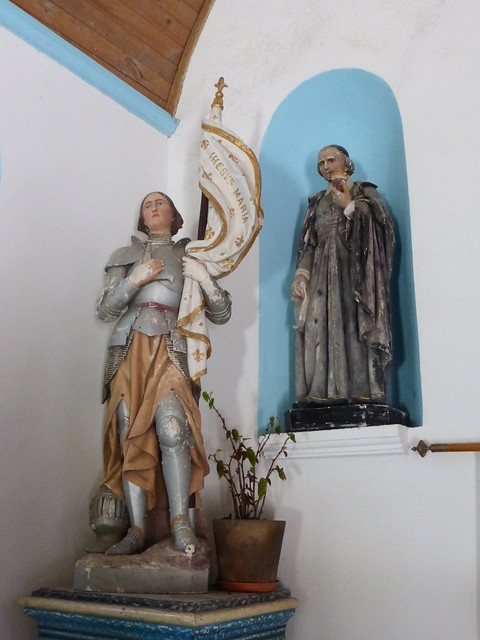 Sainte-Jeanne d'Arc and Saint-Jean Eudes
Sainte-Jeanne d'Arc and Saint-Jean Eudes 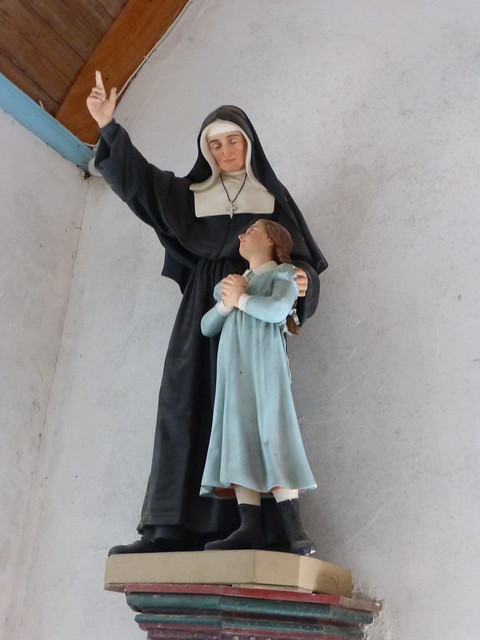 Sainte-Marie-Madeleine Postel
Sainte-Marie-Madeleine Postel 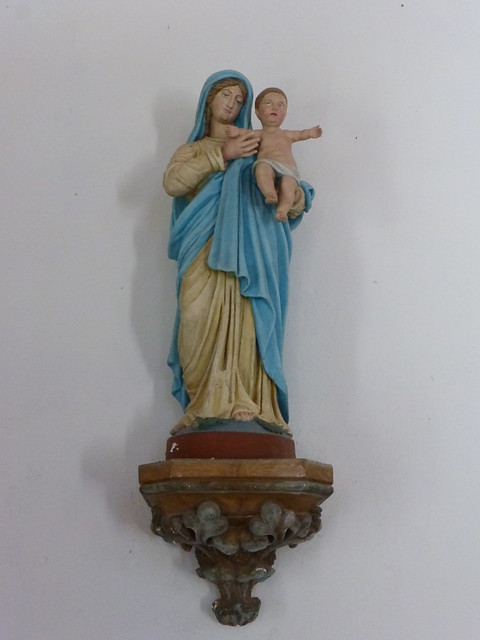 Notre-Dame de l’Huis Ouvert
Notre-Dame de l’Huis Ouvert 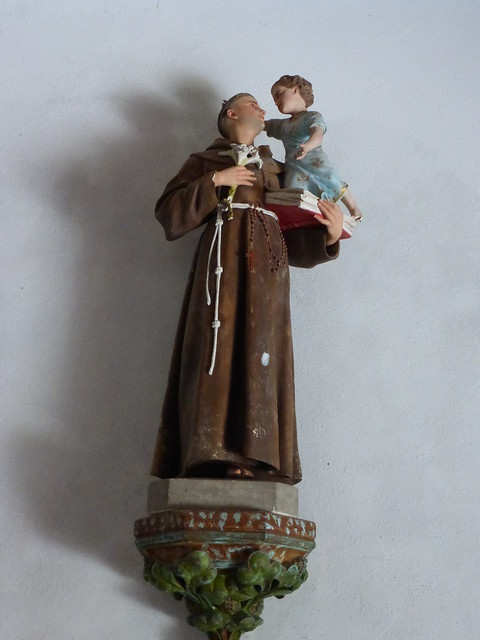 Saint-Antoine de Padoue
Saint-Antoine de Padoue 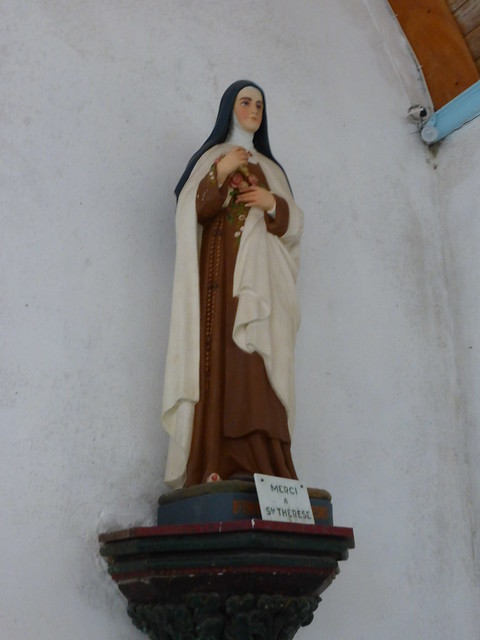 Sainte-Thérèse de l’Enfant-Jésus
Sainte-Thérèse de l’Enfant-Jésus 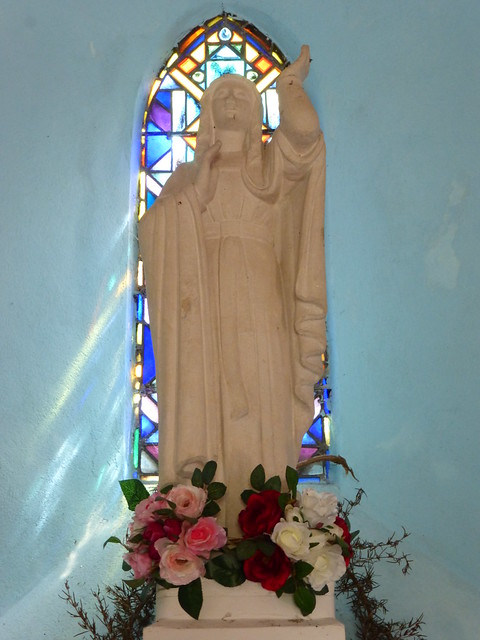 Notre-Dame de la Consolation
Notre-Dame de la Consolation 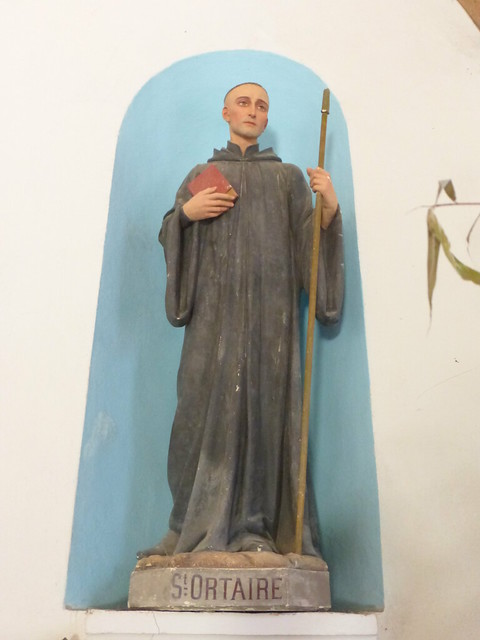 Saint-Ortaire
Saint-Ortaire
The windows are of note also for being from the workshop of famous glass maker Mauméjean. 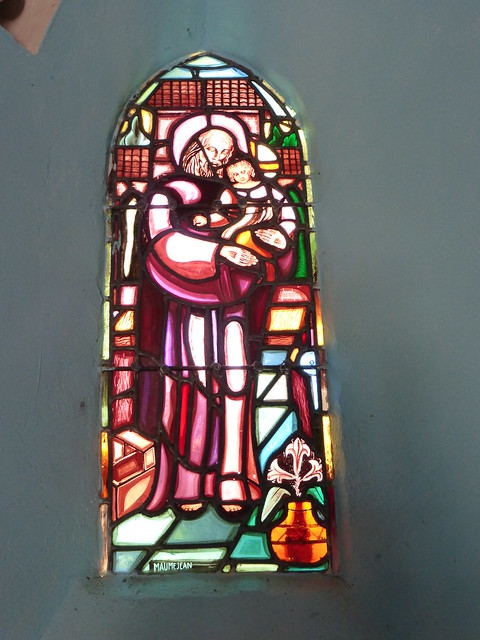 The first one depicts Saint-Joseph carrying the infant Jesus.
The first one depicts Saint-Joseph carrying the infant Jesus.  The second one depicts the apparition of the Virgin to Ste-Catherine Labouré in the chapel at the convent at Rue du Bac in Paris.
The second one depicts the apparition of the Virgin to Ste-Catherine Labouré in the chapel at the convent at Rue du Bac in Paris. 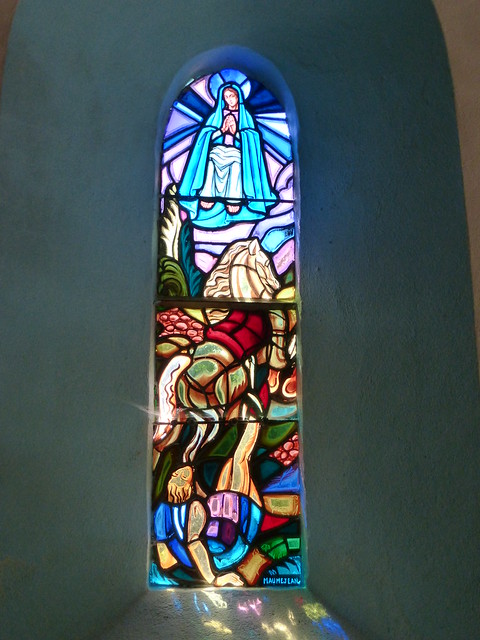 The third one depicts the apparition of the Virgin to the knight who built the chapel in Vesly.
The third one depicts the apparition of the Virgin to the knight who built the chapel in Vesly.  The fourth one depicts the Virgin blessing the mission of Father John Eudes to Vesly.
The fourth one depicts the Virgin blessing the mission of Father John Eudes to Vesly. 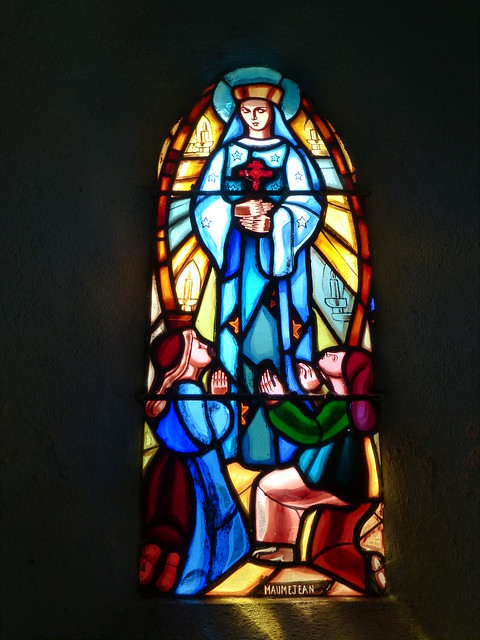 The fifth depicts the Virgin appearing to children in Pontmain.
The fifth depicts the Virgin appearing to children in Pontmain. 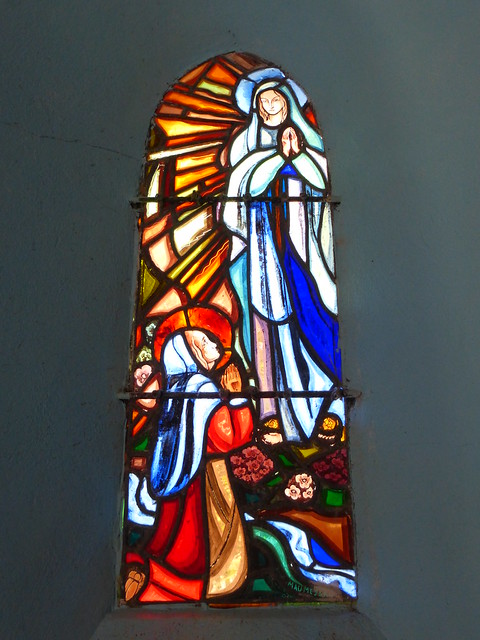 The sixth window depicts the apparition of the Immaculate Conception to Bernadette Soubirous at Lourdes.
The sixth window depicts the apparition of the Immaculate Conception to Bernadette Soubirous at Lourdes.
Published by The Baguette
-
in
Catholocism
April 21 2014
1
21
/04
/April
/2014
10:41
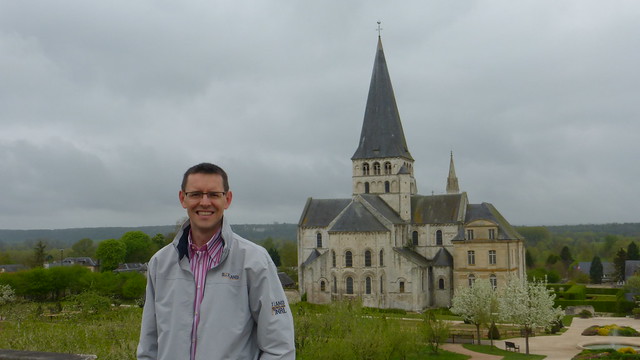
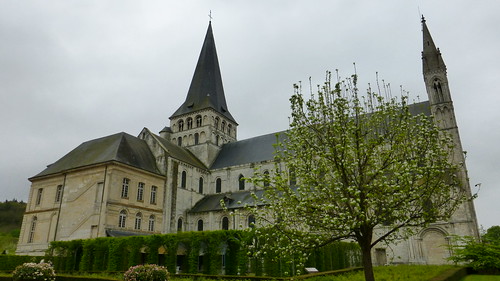
The Benedictine abbey was founded in 1144 by Guillaume de Tancarville on the site of a collegiate church built around 1050 by his father Raoul, Grand Chamberlain to William the Conqueror. Raoul de Tancarville installed a community of Augustinian Canons who were later replaced by Benedictines from St-Évroult.  No more than 40 monks were ever present and they were driven out during the French Revolution. The abbey church, which became St-Martin’s Parish Church at the time of the Revolution and so was saved from destruction, is now one of the Seine Valley’s finest small monuments. The building, which was constructed from 1080 to 1125, apart from the vaulting in the nave and transept which is 13th century, possesses a striking unity of proportion and harmony.
No more than 40 monks were ever present and they were driven out during the French Revolution. The abbey church, which became St-Martin’s Parish Church at the time of the Revolution and so was saved from destruction, is now one of the Seine Valley’s finest small monuments. The building, which was constructed from 1080 to 1125, apart from the vaulting in the nave and transept which is 13th century, possesses a striking unity of proportion and harmony. 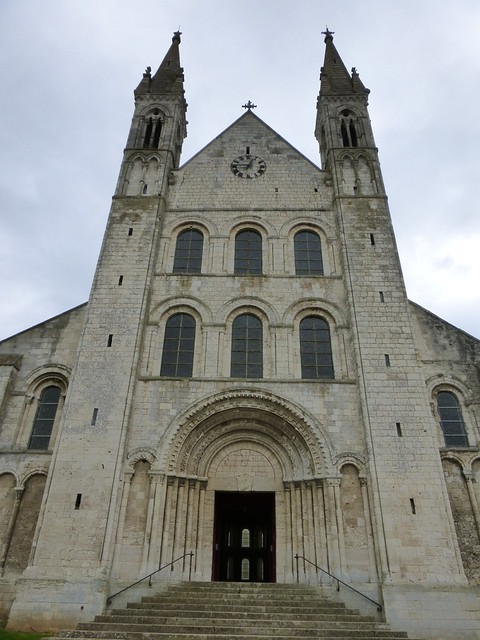 Unlike the interior of the church, the façade is quite plain and devoid of any decoration.
Unlike the interior of the church, the façade is quite plain and devoid of any decoration. 
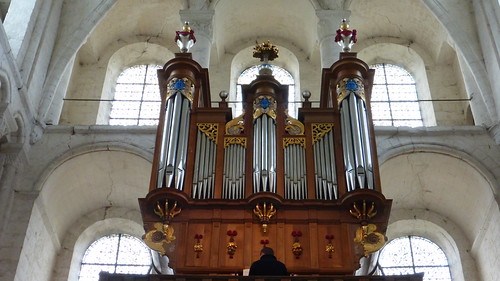
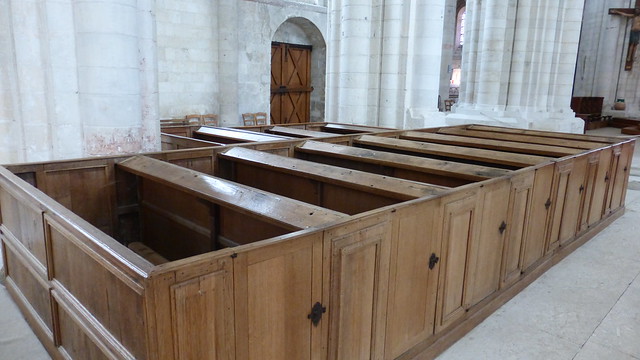

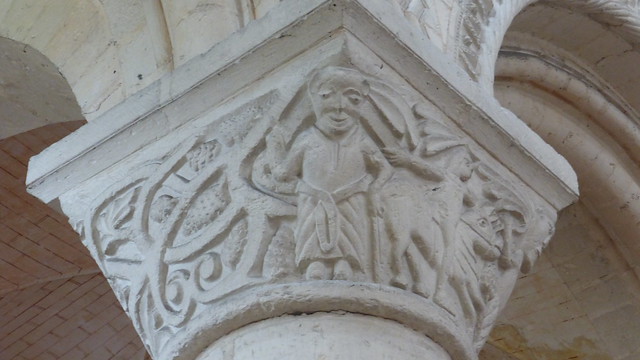
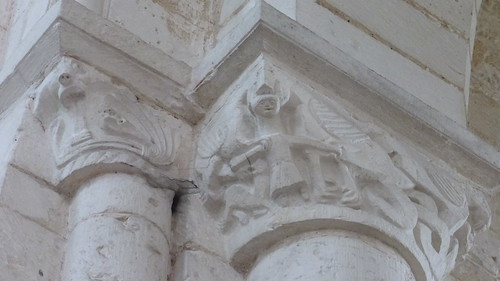
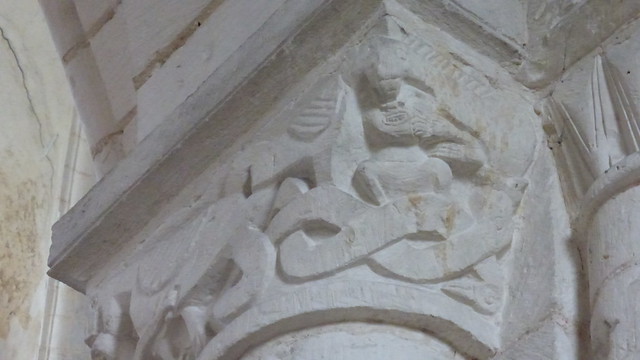 The nave has aisles on either side and many of them are adorned with decorative capitals. I was amazed at how white everything looked. It seems that the interior of the church was actually quite dark due to the walls being covered in paintings and fescoes.
The nave has aisles on either side and many of them are adorned with decorative capitals. I was amazed at how white everything looked. It seems that the interior of the church was actually quite dark due to the walls being covered in paintings and fescoes.  Over the years, these became dull and black and were finally removed during restorations.
Over the years, these became dull and black and were finally removed during restorations. 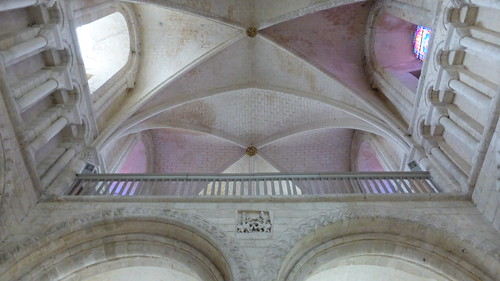
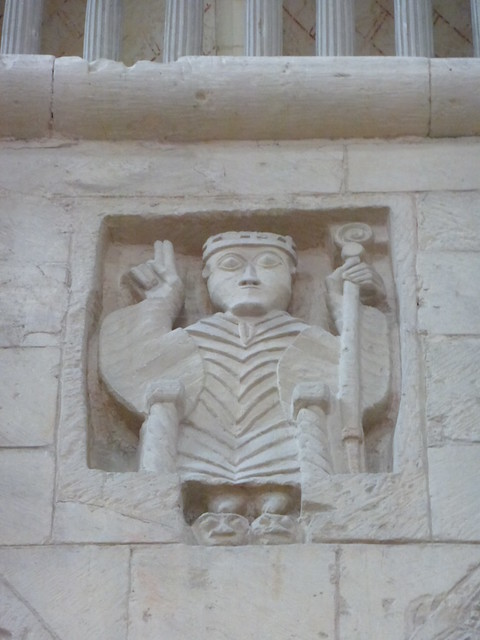
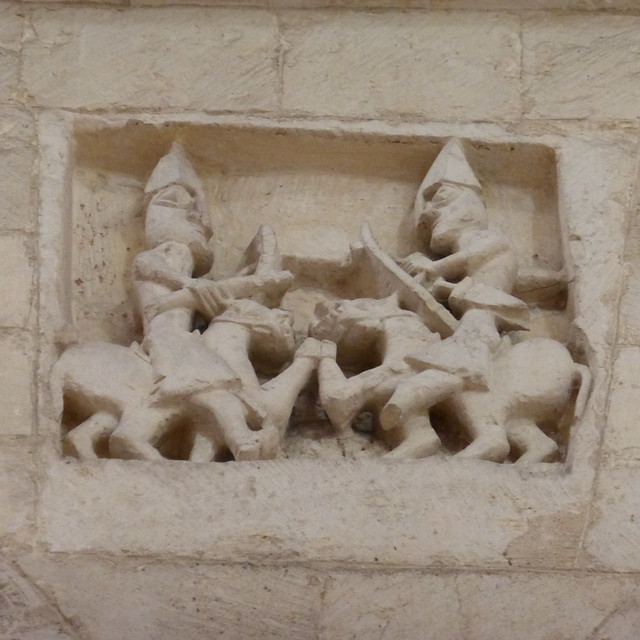 The low-relief sculptures inlaid in the wall beneath the balustrades in the transept illustrate, on the left, a bishop giving his blessing and on the right a group of warriors fighting a battle.
The low-relief sculptures inlaid in the wall beneath the balustrades in the transept illustrate, on the left, a bishop giving his blessing and on the right a group of warriors fighting a battle. 
 Perhaps the most impressive part of the church is the lantern tower directly above the main altar. There is a self-guided tour that you can follow if you have the patience to listen to someone who gives WAY too much information about every single detail.
Perhaps the most impressive part of the church is the lantern tower directly above the main altar. There is a self-guided tour that you can follow if you have the patience to listen to someone who gives WAY too much information about every single detail. 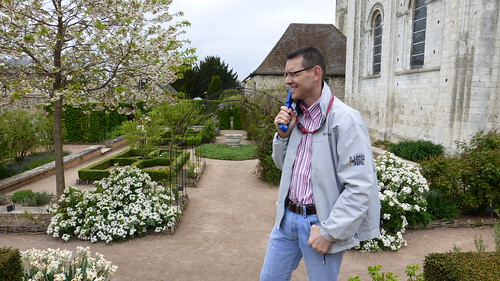
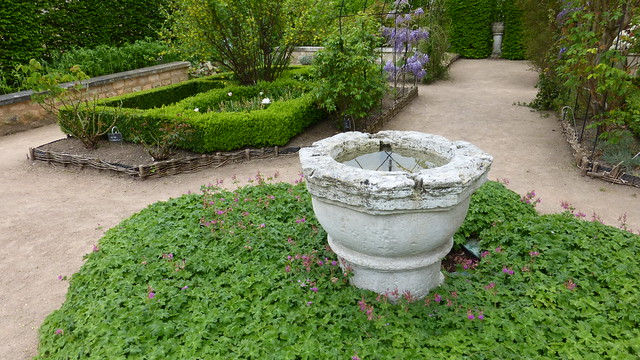 On the south side of the church is the medieval medicinal garden, known as the scented garden which is full of flowering plants of all shapes and sizes.
On the south side of the church is the medieval medicinal garden, known as the scented garden which is full of flowering plants of all shapes and sizes. 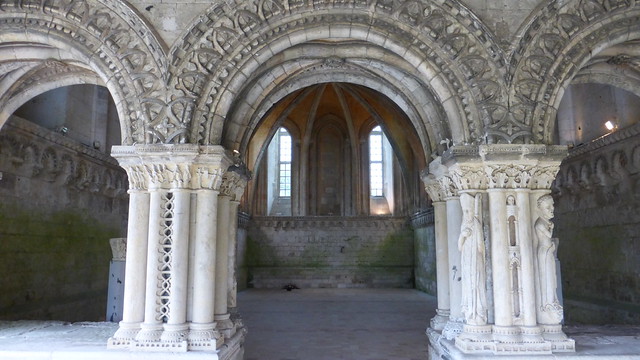
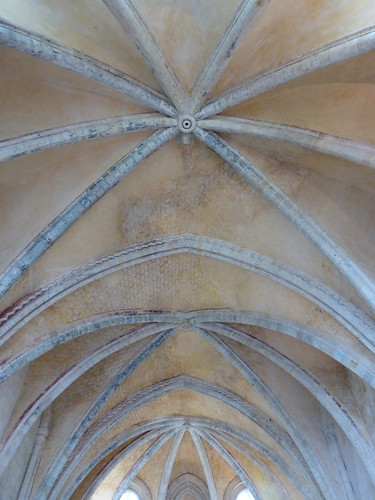

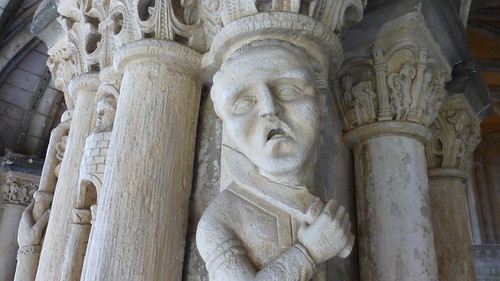

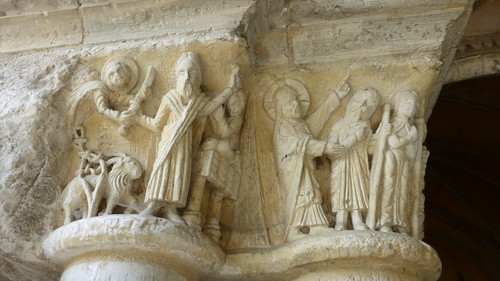
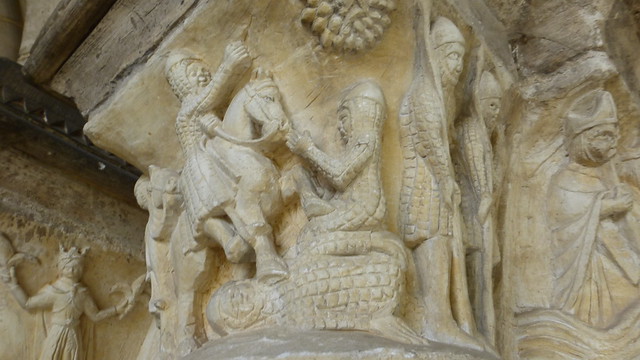 The 12th century chapter house is known for its ornamental columns with decorated capitals which tell a story. Right beside the chapter house is the former cloister.
The 12th century chapter house is known for its ornamental columns with decorated capitals which tell a story. Right beside the chapter house is the former cloister. 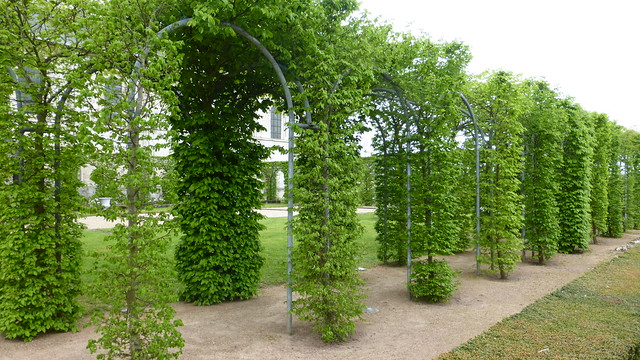
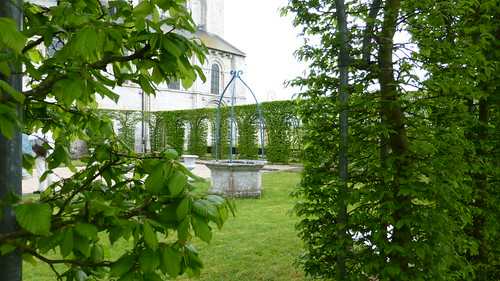
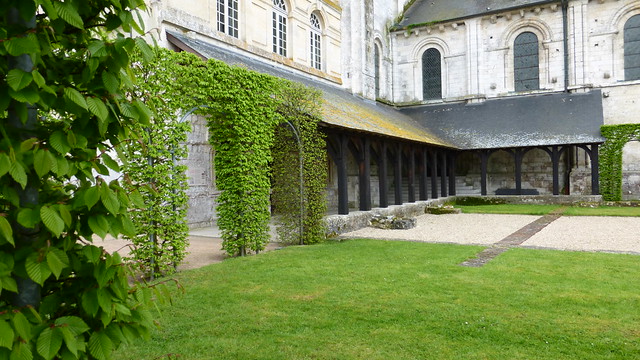 Nothing remains of this older portion of the abbey and a shrub garden has been planted to take its place. This building is one of the outbuildings built by the Maurist Benedictines in 1690. It was restored in 1994 and serves as the souvenir shop, visitors center and exhibition hall. From here, one can see the formal French garden designed in 1680 in the tradition of Le Nôtre.
Nothing remains of this older portion of the abbey and a shrub garden has been planted to take its place. This building is one of the outbuildings built by the Maurist Benedictines in 1690. It was restored in 1994 and serves as the souvenir shop, visitors center and exhibition hall. From here, one can see the formal French garden designed in 1680 in the tradition of Le Nôtre. 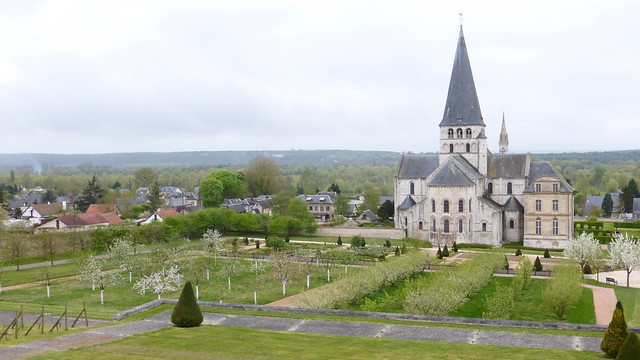

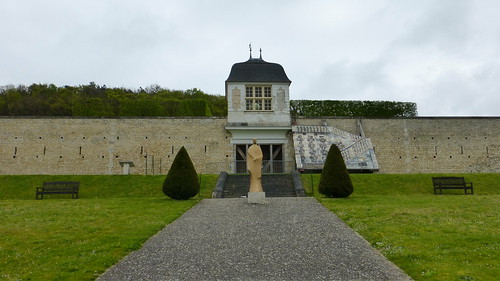 The Pavillion des Vents is a black flint and white stone lodge that crowns the monumental staircase at the back of the garden. It offers some pretty views over the abbey estate. No one knows what this small building was meant for but it quite possibly could have been used to observe the night sky.
The Pavillion des Vents is a black flint and white stone lodge that crowns the monumental staircase at the back of the garden. It offers some pretty views over the abbey estate. No one knows what this small building was meant for but it quite possibly could have been used to observe the night sky. 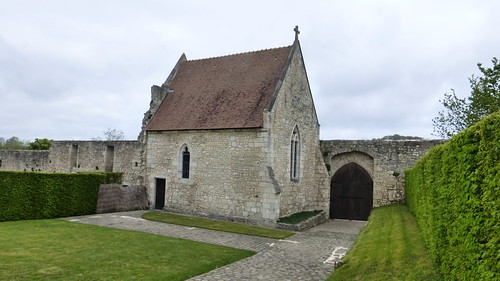 This other building is a small chapel which was converted to a storage barn after the Revolution but has now been restored to its original purpose. It is said that one monk lived here when the Benedictines moved to the abbey because he didn't like the Maurist reforms.
This other building is a small chapel which was converted to a storage barn after the Revolution but has now been restored to its original purpose. It is said that one monk lived here when the Benedictines moved to the abbey because he didn't like the Maurist reforms.
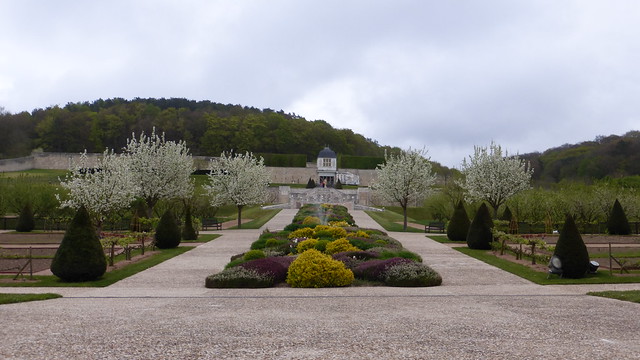
Published by The Baguette
-
in
Catholocism
April 17 2014
4
17
/04
/April
/2014
09:45
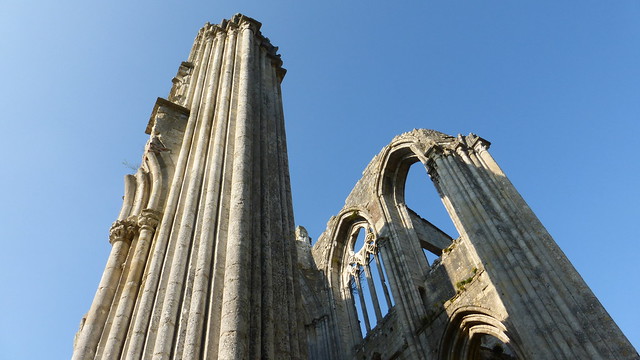
Well, it was getting rather late and after visiting Caudebec-en-Caux, we still needed to visit the Abbaye de Saint-Wandrille de Fontenelle. It is a living, working community of monks and so the buildings are not open to visitors unless you take a guided tour. Although the visitor’s center was still open, the guided tours were finished for the day. 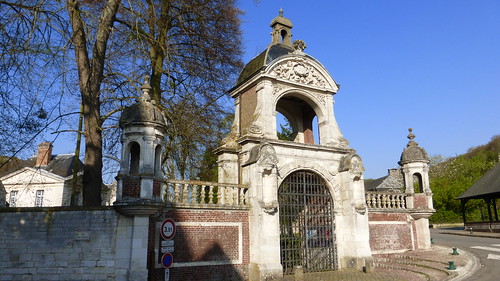 The rest of the property is open to the public and this includes some spectacular ruins that date as far back as 649 when the first community of monks moved to this area. The history of the monastery has not been at all lucky. Besides the chief basilica Saint-Wandrille built seven other churches or oratories both inside and outside the monastic enclosure.
The rest of the property is open to the public and this includes some spectacular ruins that date as far back as 649 when the first community of monks moved to this area. The history of the monastery has not been at all lucky. Besides the chief basilica Saint-Wandrille built seven other churches or oratories both inside and outside the monastic enclosure. 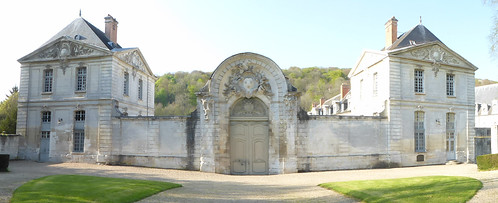 All of these have either perished in the course of time, or were replaced by others at a later date. The first church was burned down 756. In 852 it was raided by Vikings and once again burned to the ground.
All of these have either perished in the course of time, or were replaced by others at a later date. The first church was burned down 756. In 852 it was raided by Vikings and once again burned to the ground. 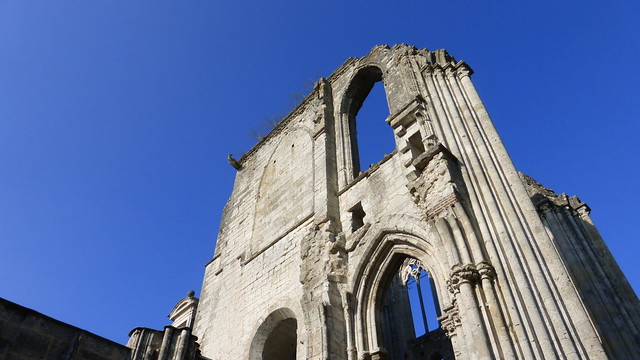 After another restoration in 966, the abbey was destroyed by lightning in 1012. After two hundred years, it burned down again in 1250.
After another restoration in 966, the abbey was destroyed by lightning in 1012. After two hundred years, it burned down again in 1250. 
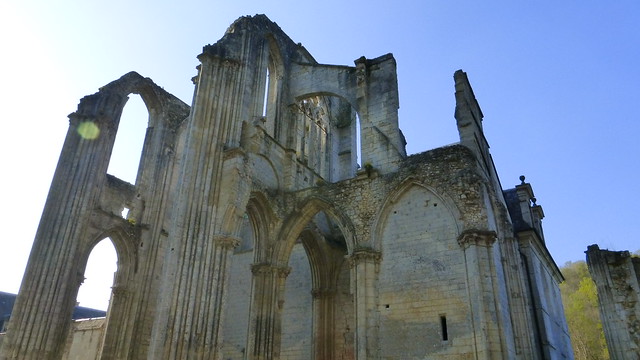 In 1631 the central tower of the church suddenly fell, ruining all the adjacent parts, but fortunately without injuring the beautiful cloisters or the conventual buildings. During the French Revolution in 1791 Fontenelle was suppressed, and in the following year the property was sold by auction. The church was partially demolished, but the rest of the buildings served for some time as a factory.
In 1631 the central tower of the church suddenly fell, ruining all the adjacent parts, but fortunately without injuring the beautiful cloisters or the conventual buildings. During the French Revolution in 1791 Fontenelle was suppressed, and in the following year the property was sold by auction. The church was partially demolished, but the rest of the buildings served for some time as a factory.  Monks came back to the area in 1898 but were expelled to Belgium in 1901. The present community of monks have been here since 1931 but once again they fell on hard times when the Germans plundered the monastery in 1940.
Monks came back to the area in 1898 but were expelled to Belgium in 1901. The present community of monks have been here since 1931 but once again they fell on hard times when the Germans plundered the monastery in 1940. 
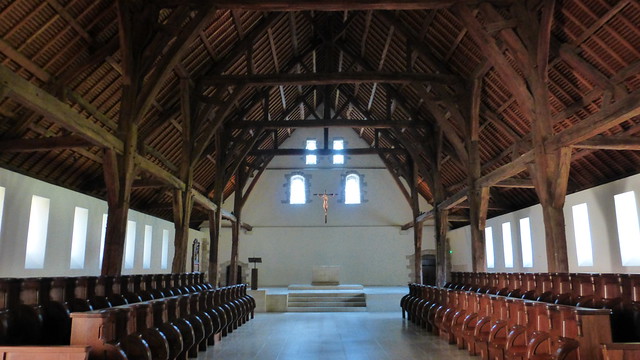 In 1969, a tithe barn from the 13th and 15th centuries from the hamlet of Canteloup à La Neuville-du-Bosc was transferred within the walls of the monastery by the monks themselves and rebuilt to become the new Abbey Church. The wood beams are bare inside and there is very little light.
In 1969, a tithe barn from the 13th and 15th centuries from the hamlet of Canteloup à La Neuville-du-Bosc was transferred within the walls of the monastery by the monks themselves and rebuilt to become the new Abbey Church. The wood beams are bare inside and there is very little light. 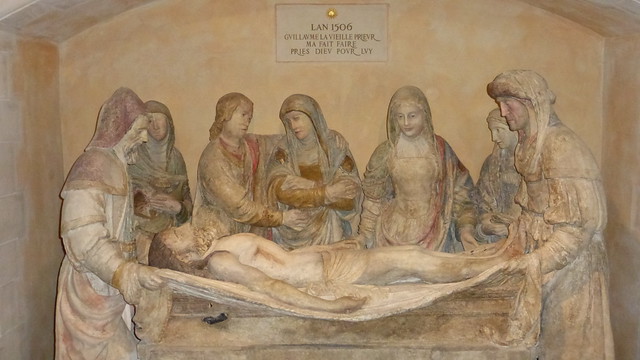 Next to the main doorway is a restored mise au tombeau from 1506.
Next to the main doorway is a restored mise au tombeau from 1506.  There is also a small, charming chapel by the monks' cemetery that is open to the public called Chapelle Notre-Dame de Caillouville-la-Neuve.
There is also a small, charming chapel by the monks' cemetery that is open to the public called Chapelle Notre-Dame de Caillouville-la-Neuve. 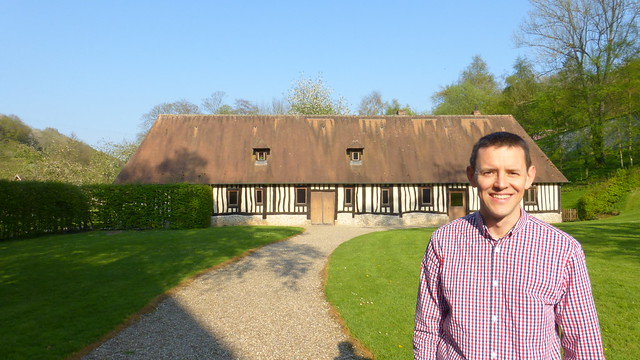
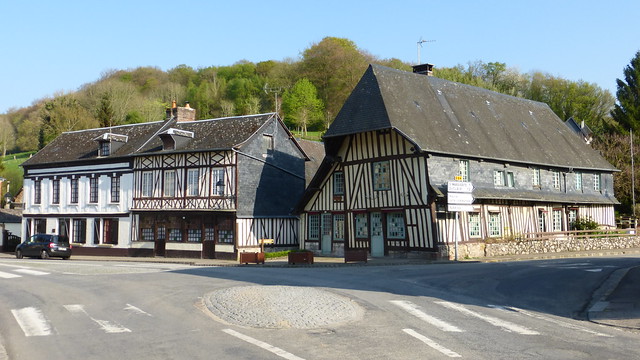 Within the town as well as the abbey property are some beautiful timber framed buildings. Just down the street is a very nice gift shop. There are products from several different monastic communities available. I purchased some beautiful Christmas cards to use next December. Near the famous abbey is the parish church which was established around 735 with materials from the Roman ruins in Lillebonne.
Within the town as well as the abbey property are some beautiful timber framed buildings. Just down the street is a very nice gift shop. There are products from several different monastic communities available. I purchased some beautiful Christmas cards to use next December. Near the famous abbey is the parish church which was established around 735 with materials from the Roman ruins in Lillebonne. 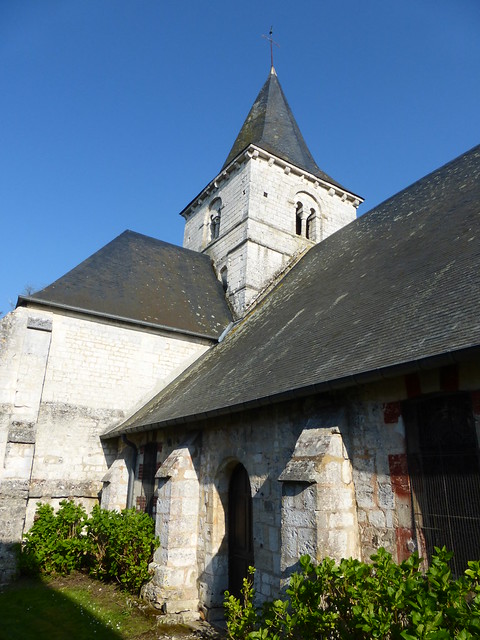
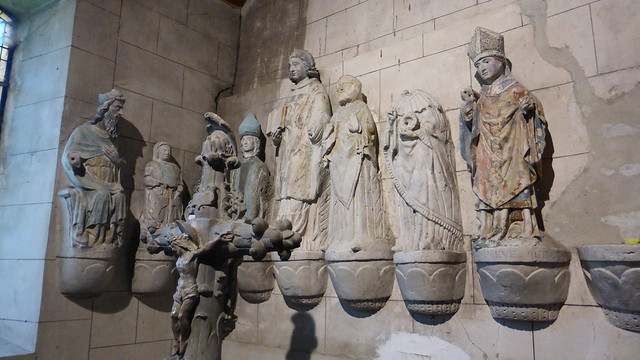 The building was destroyed during the Norman invasions, but rebuilt in wood and stone in the eleventh century. It has a rather sombre interior with walls lined with numerous statues from different centuries.
The building was destroyed during the Norman invasions, but rebuilt in wood and stone in the eleventh century. It has a rather sombre interior with walls lined with numerous statues from different centuries.
Published by The Baguette
-
in
Catholocism
April 10 2014
4
10
/04
/April
/2014
09:27
Published by The Baguette
-
in
Catholocism
March 15 2014
6
15
/03
/March
/2014
15:19
After leaving Laval, we headed to our final destination for the day, Évron but stopped just long enough in La Chapelle- Rainsouin to see the interior of l'église Saint-Sixte which is famous for its two funeral stones as well as a unique Entombment scene. One of the most interesting things about this church is the vaulted, wooden "reversed keel" ceiling that covers the nave. This beautiful carpentry work was probably established in 1506 and only repaired in 1842. On the right after entering is a narrow splayed window which indicates that the original walls of the church were Romanesque in design but it is now thought that most of the masonry actually dates from the end of the Middle Ages. Another interesting feature along the walls upon entering are the 17th century “litre funéraire” or black funeral bands painted to honor the deceased lords of La Chapelle-Rainsouin known as the Le Prestre from the 17th century. On either side of the main altar are statues dedicated to Sainte-Anne and Saint-Sébastien. The altarpiece is a beautiful piece of classical architecture with alternating columns of red and black marble framing a painting depicting the Descent from the Cross. Three statues round off the decor: at the top, Saint-Sixtus; on the left, Saint-Mammès with a lion; and on the right, Saint-Peter. Above two of the statues are the arms of the family Le Prestre. The entire ensemble was executed in 1701 by François Trouillard, architect and sculptor from Château-Gontier, who pledged to deliver it within a period of one year along with three statues "gilded and detailed for the price of 1100 livres." Within the north chapel named "Montfronchet" are two carved stones that once covered the tombs of the founders of the chapel. They were set against the wall in 1821 and have been identified as Olivier de La Chapelle and Arthuse de Melun and were most likely created between 1508 and 1526. Alone in the back of the church, within a small room locked with an iron gate, is a set of statues known as the Entombment, or Burial of Christ. The scene is composed of seven characters which surround Christ lying in his shroud. The two statues on either end represent Joseph of Arimathea and Nicodemus. In the background are the three holy women, the Virgin and Saint John. These statues were executed in 1522 by someone named Gnothus and ordered by Arthuse de Melun. One stained glass window along the southern wall depicts Saint Charles Borromeo blessing the people of Milan during an outbreak of the plague in 1576. Above the western portal is a beautiful stained glass window commemorating the seventh and eighth crusades of Saint-Louis IX.
Published by The Baguette
-
in
Catholocism
March 13 2014
4
13
/03
/March
/2014
16:15
On January 17, 1871, the Virgin Mary appeared to four children in the village of Pontmain: Eugène and Joseph Barbedette, Jeanne-Marie Lebossé and Françoise Richer. The children said that the Lady was clothed in a blue dress, spangled with golden stars. On her head which was covered with a black veil falling down her back, there was a golden crown with a red band around it. Then surrounding the Lady, three bright stars appeared forming a triangle. When the parish priest Michel Guérin arrived on the scene, a small red cross appeared on the Virgin’s breast, while a blue oval with four candles inside, surrounded the apparition. Soon, under her feet, a scroll unrolled, on which, one by one, golden letters appeared; they were spelled out in a loud voice by the children: MAIS PRIEZ MES ENFANTS DIEU VOUS EXAUCERA EN PEU DE TEMPS. MON FILS SE LAISSE TOUCHER. (Pray my children. God will answer you very soon. My son lets himself be touched.) After the apparition, there was a thorough and quick investigation under the guidance of Monsignor Casimir Wicart, Bishop of Laval who acknowledged the authenticity of the apparition and approved the cult of the Virgin of Pontmain on February 2, 1872. The influx of pilgrims to Pontmain was fast. On the first anniversary of the apparitions, January 17, 1872, there were already 8,000 people. Monsignor Wicart laid the first stone of a new sanctuary in Pontmain on June 18, 1873 but died soon after. After the appearance of the Virgin Mary in 1871 and the official recognition of the miracle by the Catholic Church, the Oblates of Mary Immaculate were invited to supervise the construction of the new sanctuary. They moved into a large building built northwest of the building site, the House of the Oblates. Monsignor Wicart’s successors followed his path and the sanctuary was finally dedicated on October 15, 1900 by Monsignor Pierre Geay. In 1908, Pope Pius X elevated the sanctuary to a basilica. In 1946, the ceremonies of the 75th anniversary of the apparition were presided over by the Apostolic Nuncio Archbishop Roncalli, the future Pope John XXIII. The vast neo-Gothic basilica with its twin granite spires dwarfs the other buildings of the small village. The statue of the Virgin rests on a column to the left of the façade. The ten stained-glass windows in the chancel depict the Virgin’s apparitions in France, including Pontmain, Lourdes and La Salette, as well as scenes from the life of Christ. Attached to the House of the Oblates is its chapel built in 1953. From the outside, it has a heavy appearance but is surprisingly pleasing within, illuminated by a golden light diffused by the lower stained-glass windows and an enormous stained glass window of Christ in Majesty above the chancel. The stained-glass was designed by master glassmaker Gabriel Loire. Standing alongside the basilica, the parish church appears quite modest. Devoted to the Apostles Simon and Jude, the old Romanesque church was in ruins when Father Guérin arrived in Pontmain on October 26, 1836. He undertook the work of expansion and beautification. He had the vault painted in blue with gold stars, statues of the Virgin placed throughout and later had images of the apparition painted on the ceilings.
Published by The Baguette
-
in
Catholocism
March 31 2013
7
31
/03
/March
/2013
00:01
He is risen ! Happy Easter, everyone ! Some photos of my Easter decorations.
Published by The Baguette
-
in
Catholocism
January 6 2013
7
06
/01
/January
/2013
08:38
Le terme "épiphanie" est issu du grec et signifie "apparition". Célébrée le 6 janvier, cette fête correspond à la présentation de Jésus enfant aux Rois Mages. Ce jour est aussi celui du premier miracle des noces de Cana et avant tout la date de baptême du Christ. La galette des rois, est une tradition typiquement française qui avait déjà cours au XIVe siècle. La galette était partagée en autant de portions que de convives, plus une. Cette portion supplémentaire, appelée "part du Bon Dieu" ou "part de la Vierge", était destinée au premier pauvre qui se présenterait.
Published by The Baguette
-
in
Catholocism
November 21 2012
3
21
/11
/November
/2012
08:28
I was in Bricquebec last Friday and Saturday for the Week-end sur l'Esprit Saint, part of the Parcours Alpha of which I belong.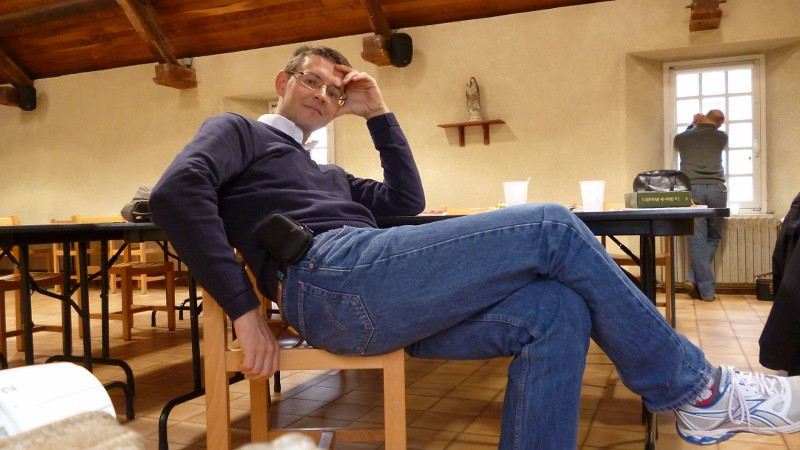
And I say unto you, Ask, and it shall be given you; seek, and ye shall find; knock, and it shall be opened unto you. For every one that asketh receiveth; and he that seeketh findeth; and to him that knocketh it shall be opened... how much more shall your heavenly Father give the Holy Spirit to them that ask him? |
Published by The Baguette
-
in
Catholocism
June 19 2012
2
19
/06
/June
/2012
11:07
Hello everyone ! I am back ! My Camino experience was amazing!
Published by The Baguette
-
in
Catholocism
 In the 13th century, a gentleman was riding in the vicinity of the place where the chapel is now standing. Suddenly, he came across a boar which rushed at the horse. The horse bolted and knocked the knight down. Unfortunately, one of the knight’s feet got stuck in the stirrup and he was dragged by the bolting horse. When he was about to die, the gentleman promised the Blessed Virgin that he would build a chapel at the very place where his life would be spared. His foot being released, the gentleman soon set about fulfilling his vow. He dedicated the chapel he built to Our Lady of the Stirrup (Notre-Dame de l'Étrier) or of the Saddle (Notre-Dame de la Selle). Such is the origin, according to legend, of the Vesly Chapel.
In the 13th century, a gentleman was riding in the vicinity of the place where the chapel is now standing. Suddenly, he came across a boar which rushed at the horse. The horse bolted and knocked the knight down. Unfortunately, one of the knight’s feet got stuck in the stirrup and he was dragged by the bolting horse. When he was about to die, the gentleman promised the Blessed Virgin that he would build a chapel at the very place where his life would be spared. His foot being released, the gentleman soon set about fulfilling his vow. He dedicated the chapel he built to Our Lady of the Stirrup (Notre-Dame de l'Étrier) or of the Saddle (Notre-Dame de la Selle). Such is the origin, according to legend, of the Vesly Chapel.  As for its cloister, in the 14th and 15th centuries, it was used as the burial place for the local gentry. Over the years, many old sarcophagi have been found here during archaeological digs. In 1650, Father John Eudes, preaching a mission in Vesly, found the chapel nearly in ruins. It was a long time since Mass had been said. The missionary announced a procession to the chapel on Easter Tuesday. The parishioners of Vesly and of the neighbourhood responded to the appeal. Father Eudes then felt a desire to restore the chapel of the Blessed Virgin during his stay in Vesly. This task was undertaken so eagerly that the missionary was able to say Mass in the newly restored chapel at the end of his mission. Seeing this achievement as a good sign from the Blessed Virgin that his mission was a success, Father Eudes then dedicated the chapel to Our Lady of Consolation which is now its name. The interior has eight statues:
As for its cloister, in the 14th and 15th centuries, it was used as the burial place for the local gentry. Over the years, many old sarcophagi have been found here during archaeological digs. In 1650, Father John Eudes, preaching a mission in Vesly, found the chapel nearly in ruins. It was a long time since Mass had been said. The missionary announced a procession to the chapel on Easter Tuesday. The parishioners of Vesly and of the neighbourhood responded to the appeal. Father Eudes then felt a desire to restore the chapel of the Blessed Virgin during his stay in Vesly. This task was undertaken so eagerly that the missionary was able to say Mass in the newly restored chapel at the end of his mission. Seeing this achievement as a good sign from the Blessed Virgin that his mission was a success, Father Eudes then dedicated the chapel to Our Lady of Consolation which is now its name. The interior has eight statues:  Sainte-Jeanne d'Arc and Saint-Jean Eudes
Sainte-Jeanne d'Arc and Saint-Jean Eudes  Sainte-Marie-Madeleine Postel
Sainte-Marie-Madeleine Postel  Notre-Dame de l’Huis Ouvert
Notre-Dame de l’Huis Ouvert  Saint-Antoine de Padoue
Saint-Antoine de Padoue  Sainte-Thérèse de l’Enfant-Jésus
Sainte-Thérèse de l’Enfant-Jésus  Notre-Dame de la Consolation
Notre-Dame de la Consolation  Saint-Ortaire
Saint-Ortaire  The first one depicts Saint-Joseph carrying the infant Jesus.
The first one depicts Saint-Joseph carrying the infant Jesus.  The second one depicts the apparition of the Virgin to Ste-Catherine Labouré in the chapel at the convent at Rue du Bac in Paris.
The second one depicts the apparition of the Virgin to Ste-Catherine Labouré in the chapel at the convent at Rue du Bac in Paris.  The third one depicts the apparition of the Virgin to the knight who built the chapel in Vesly.
The third one depicts the apparition of the Virgin to the knight who built the chapel in Vesly.  The fourth one depicts the Virgin blessing the mission of Father John Eudes to Vesly.
The fourth one depicts the Virgin blessing the mission of Father John Eudes to Vesly.  The fifth depicts the Virgin appearing to children in Pontmain.
The fifth depicts the Virgin appearing to children in Pontmain.  The sixth window depicts the apparition of the Immaculate Conception to Bernadette Soubirous at Lourdes.
The sixth window depicts the apparition of the Immaculate Conception to Bernadette Soubirous at Lourdes. 




















































